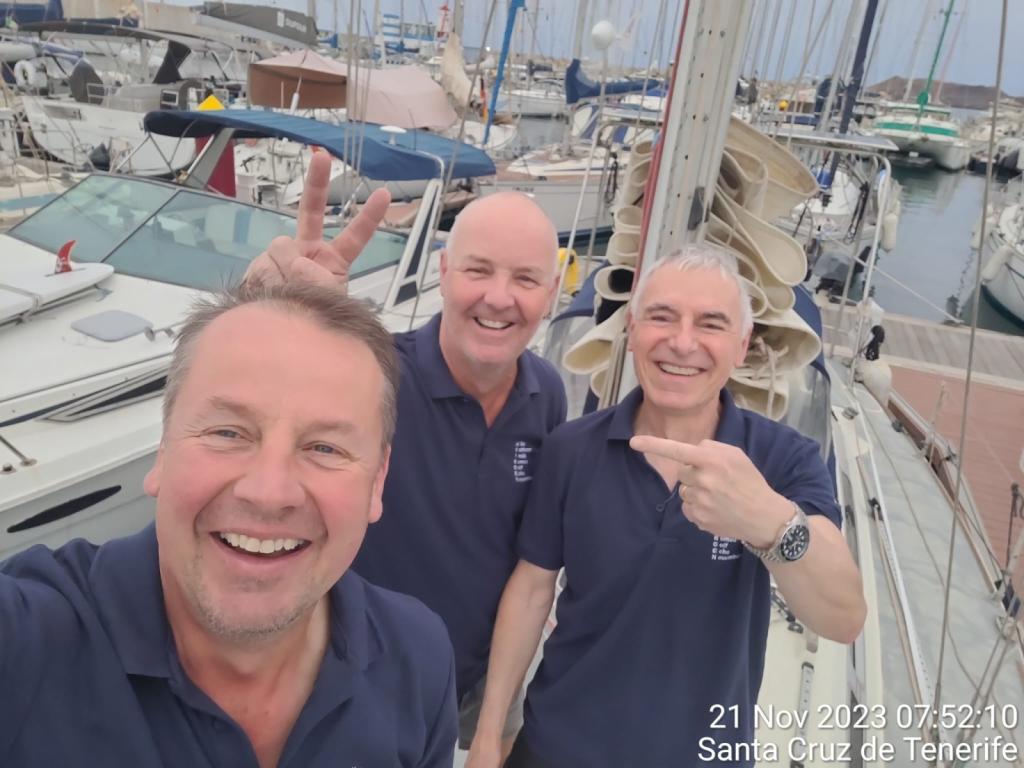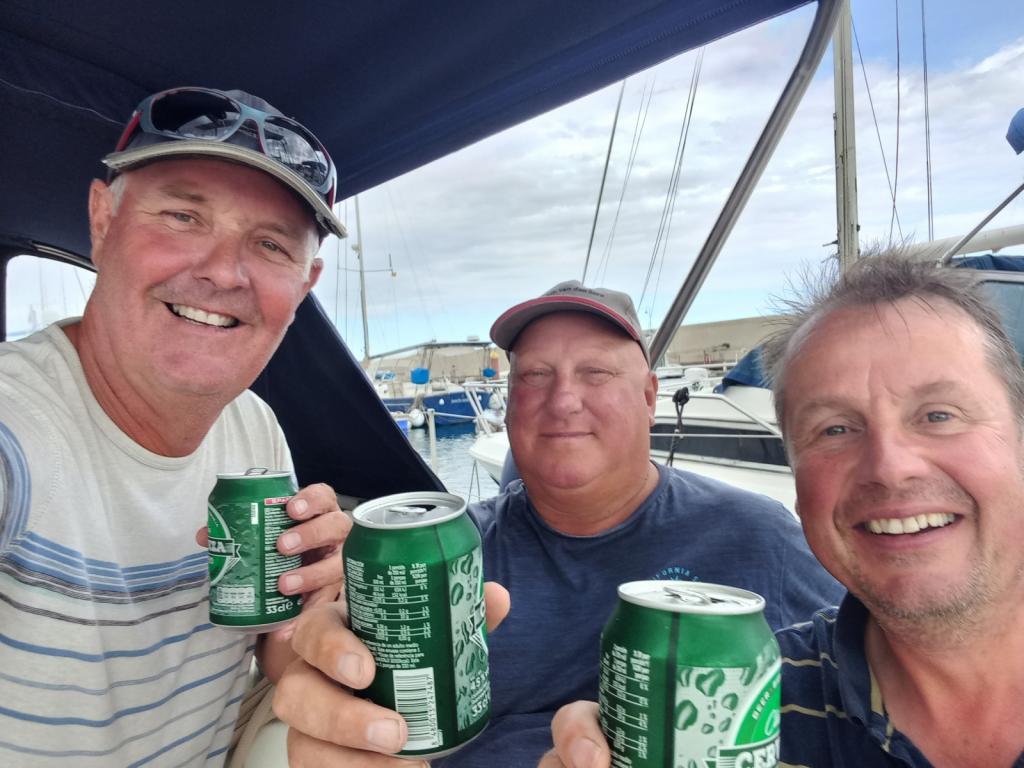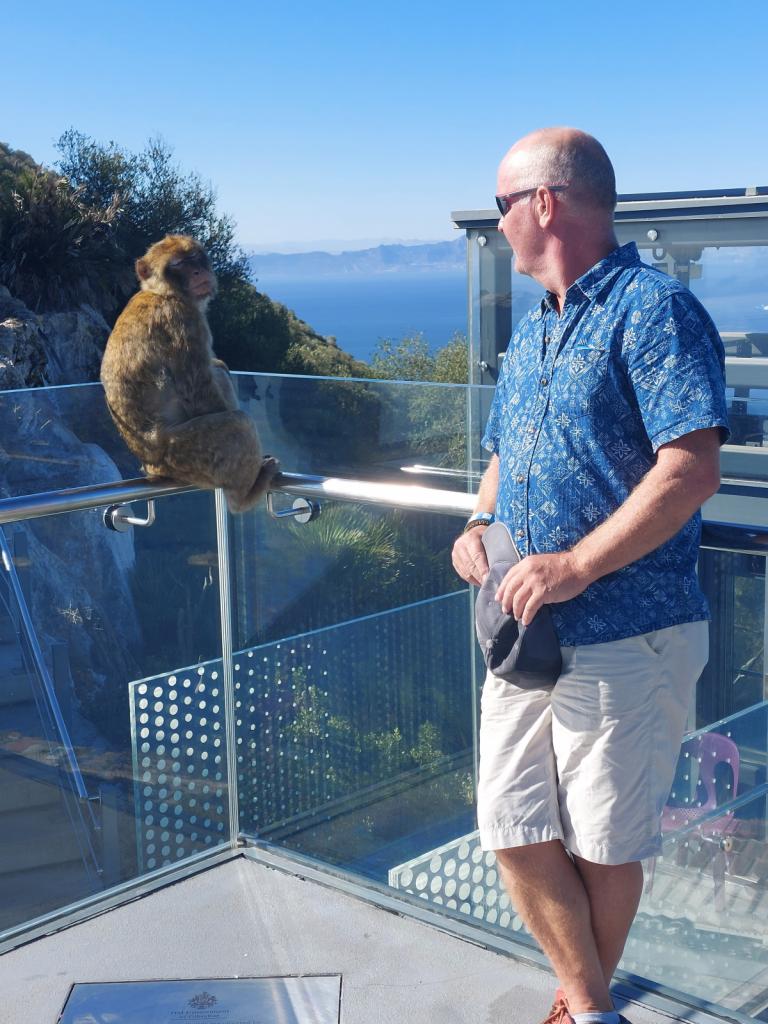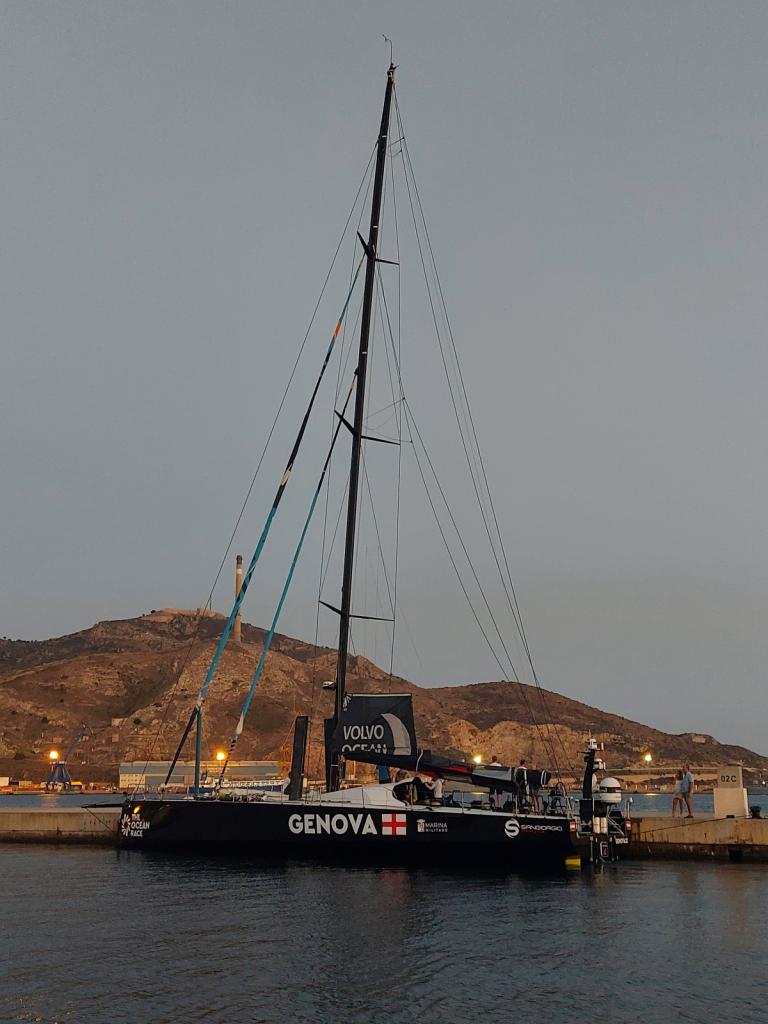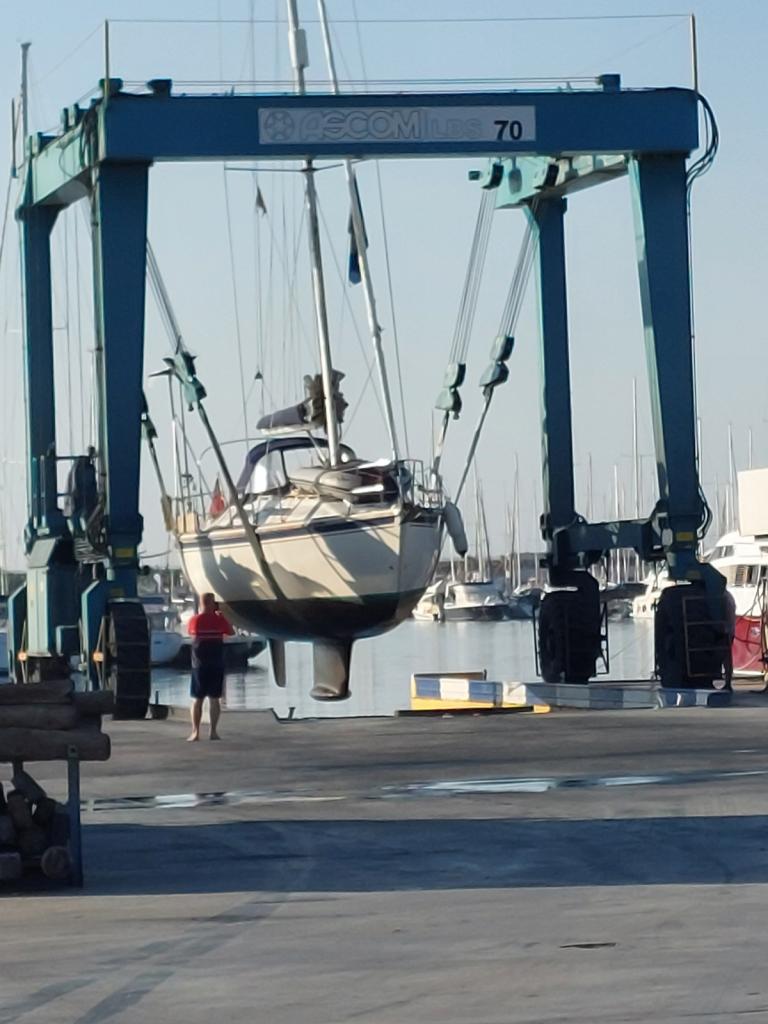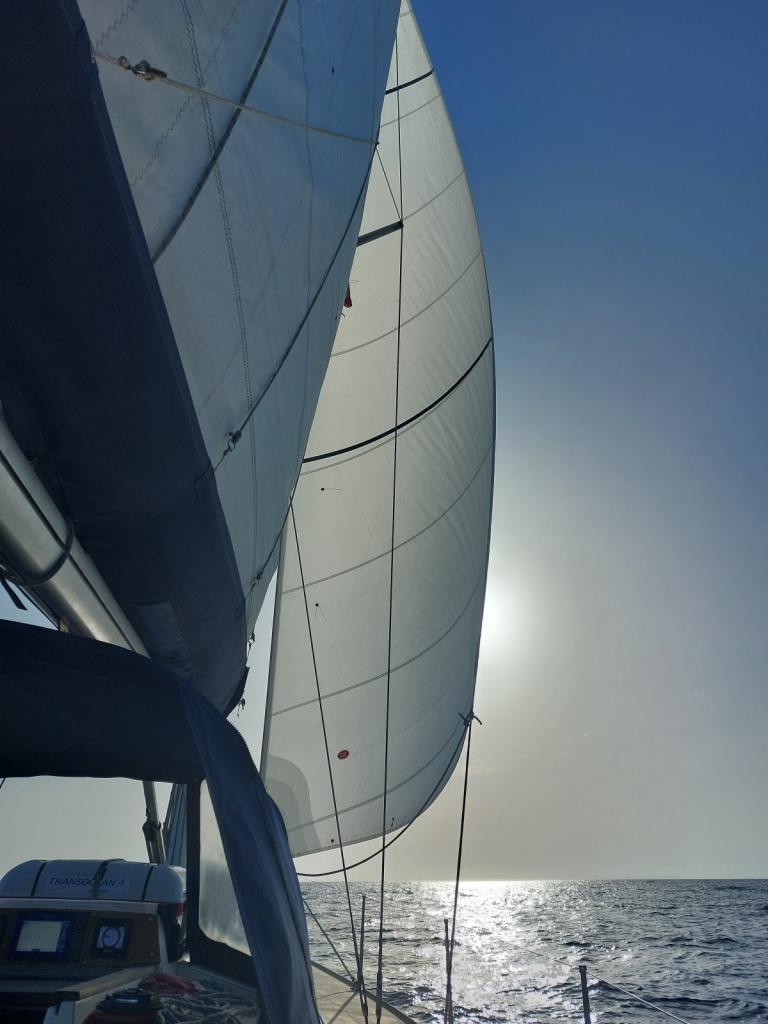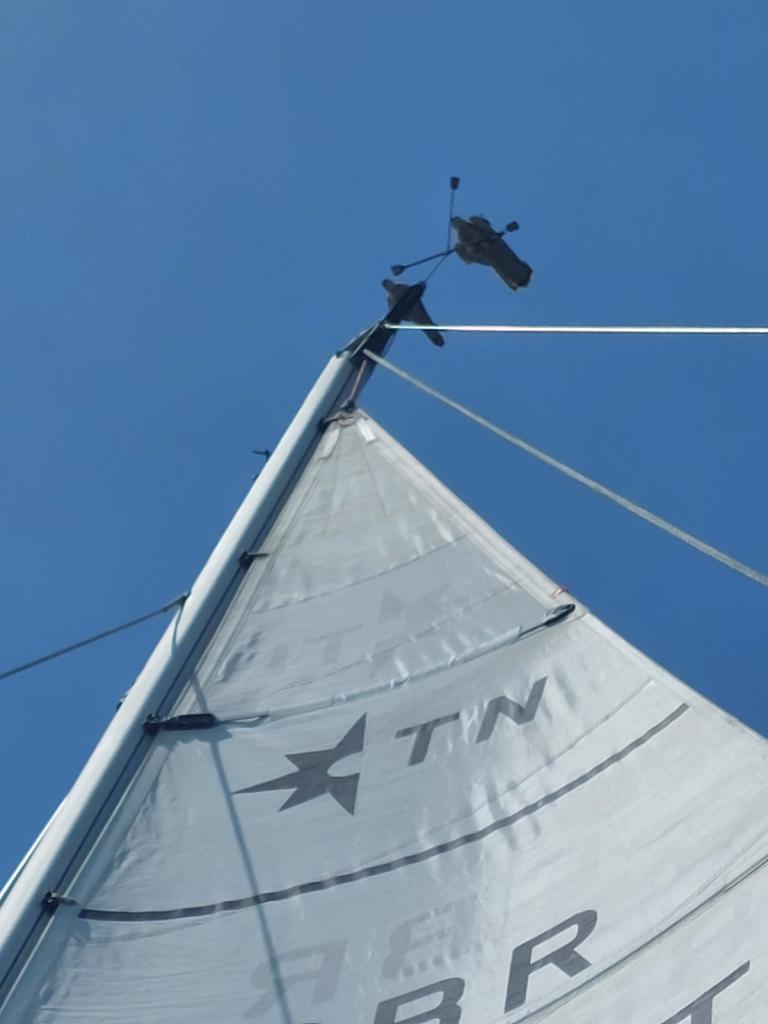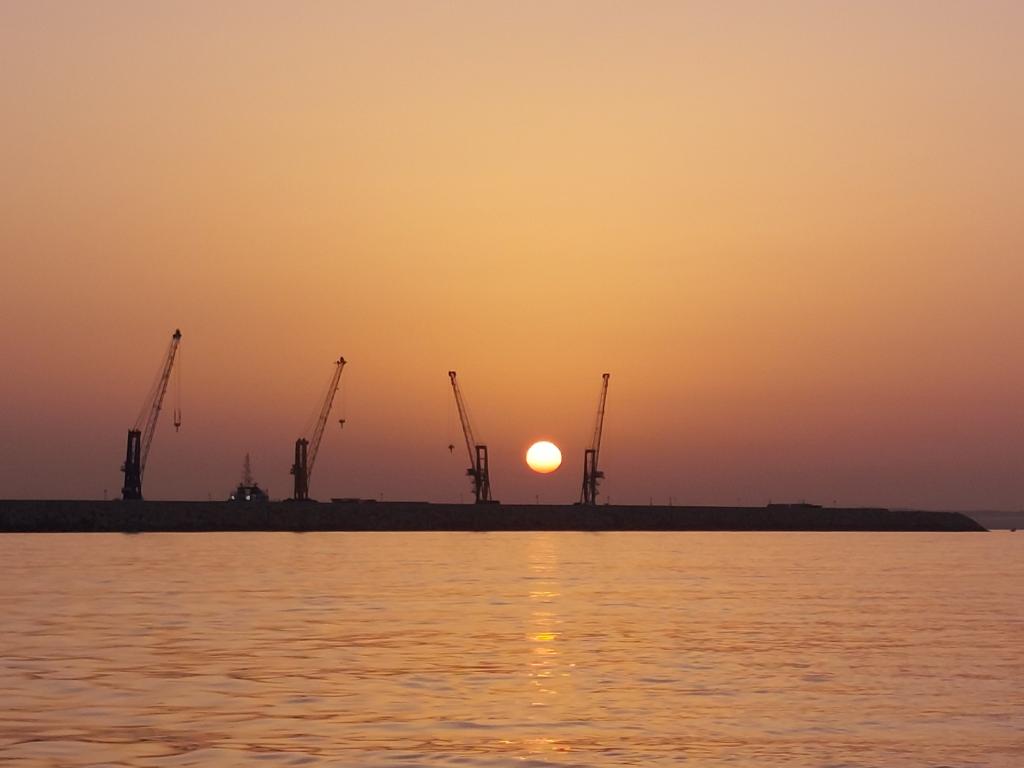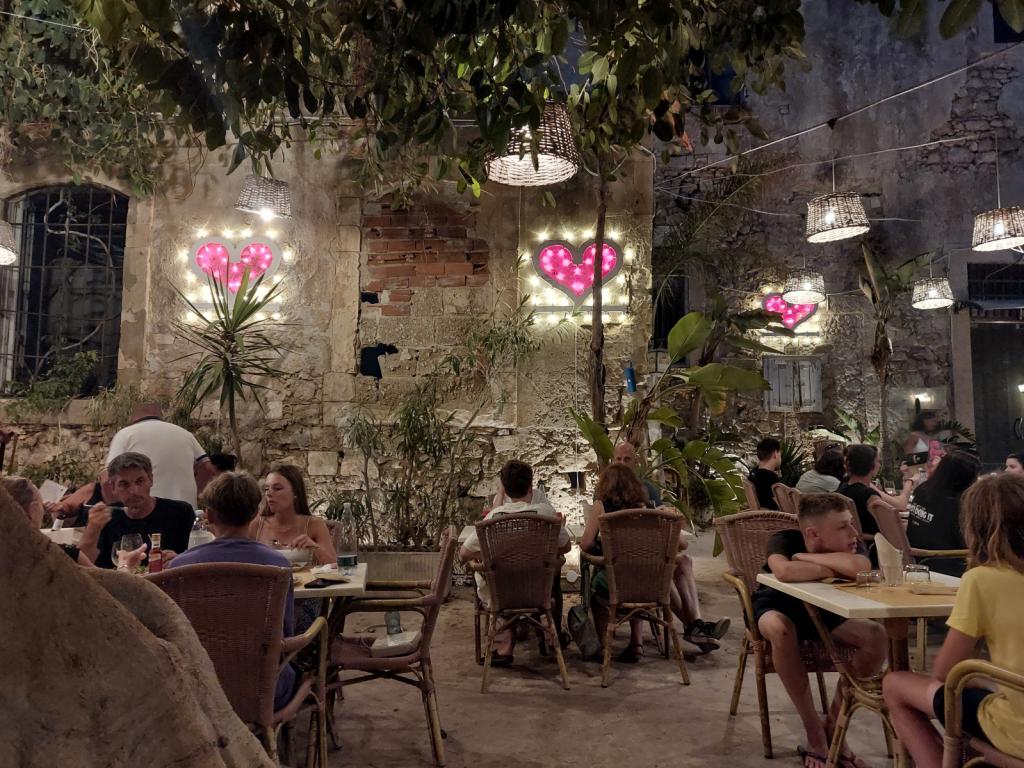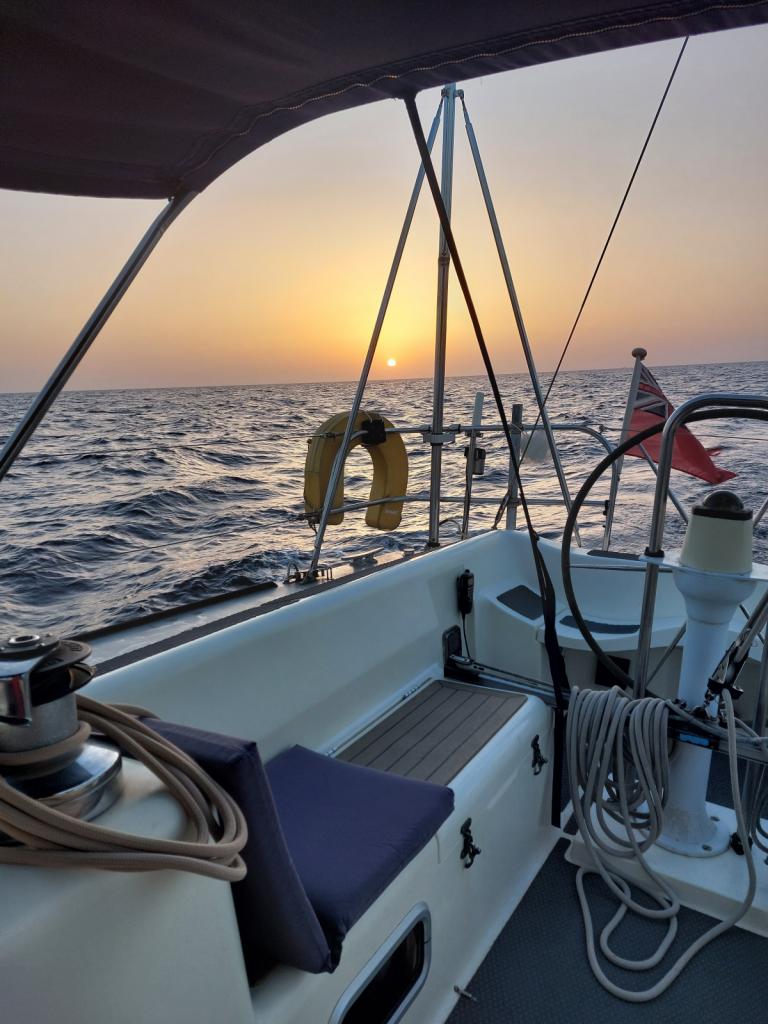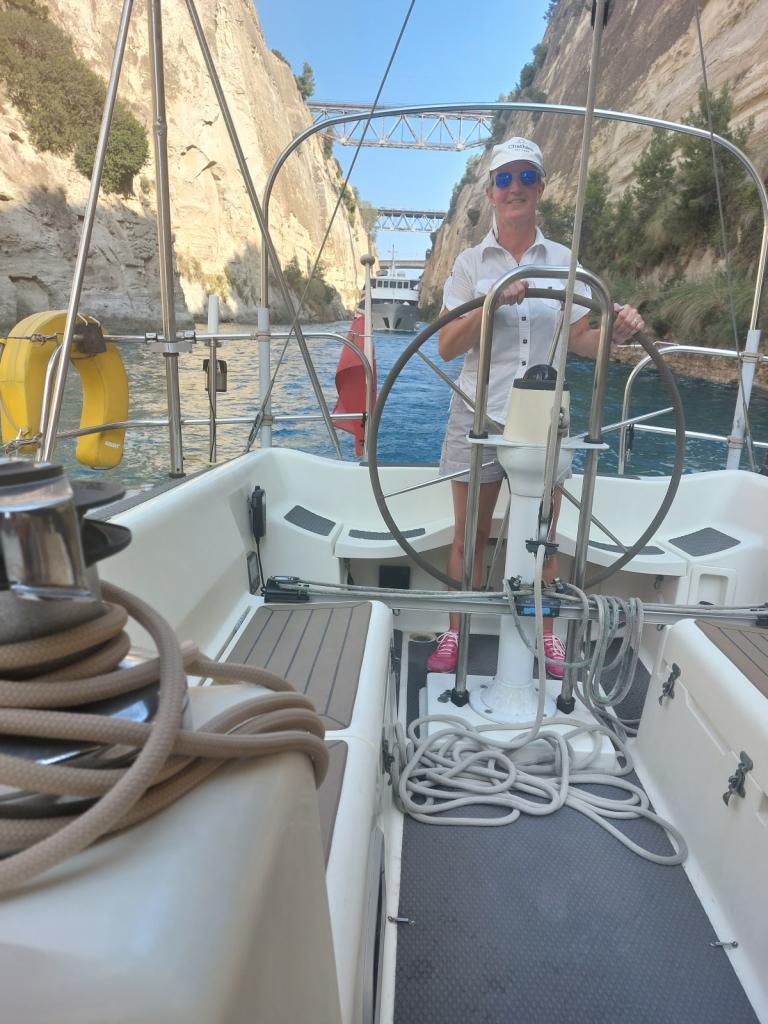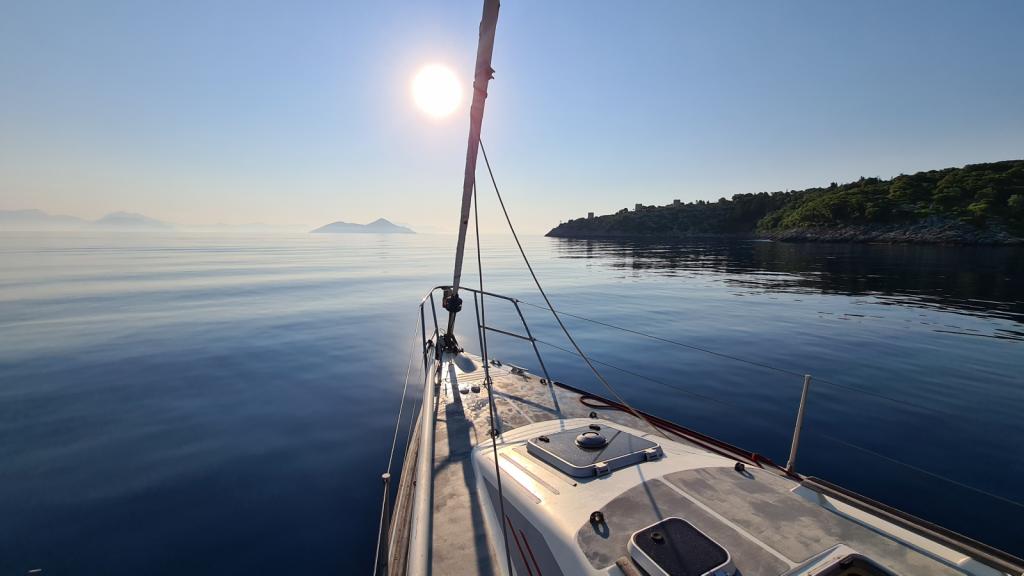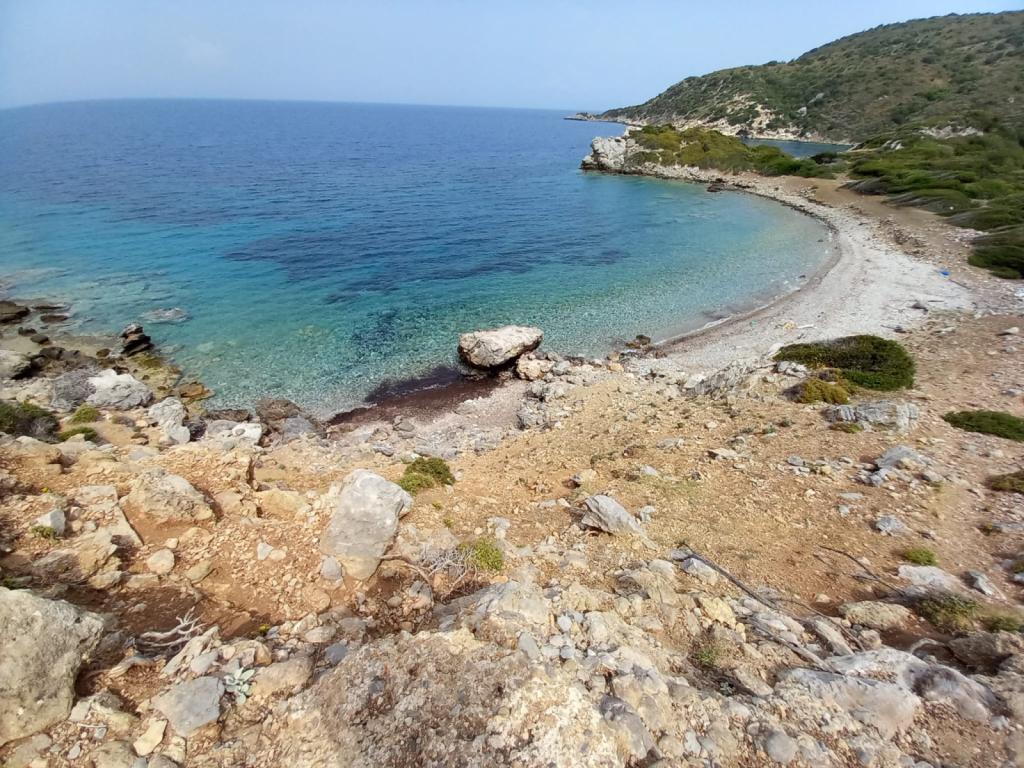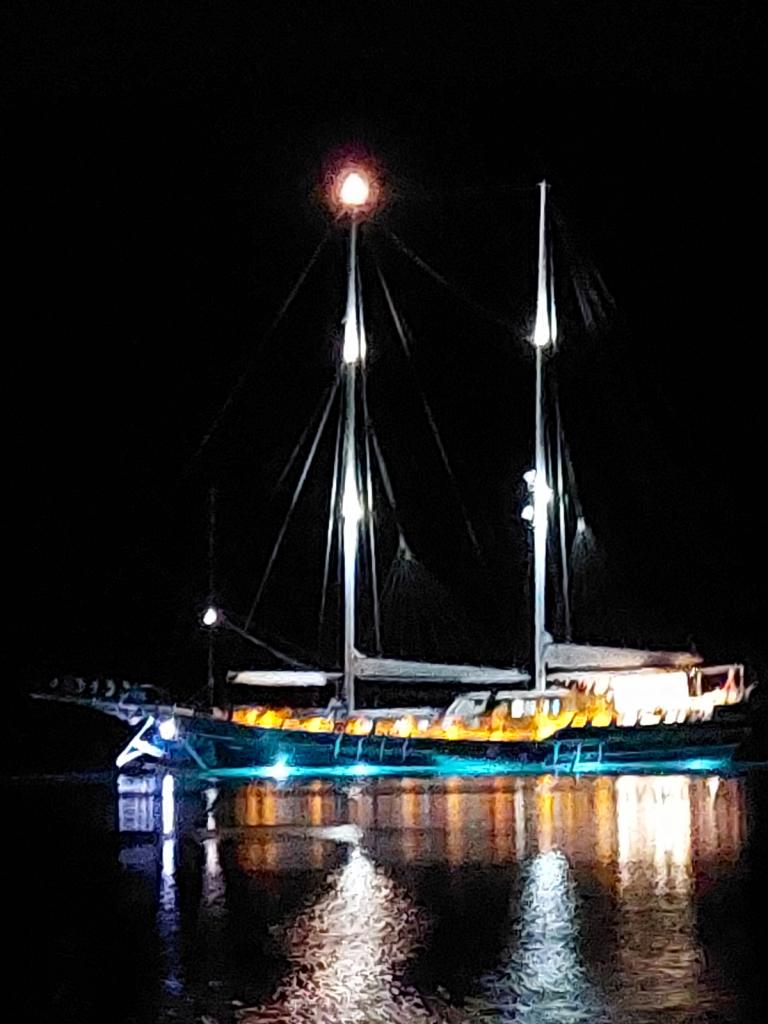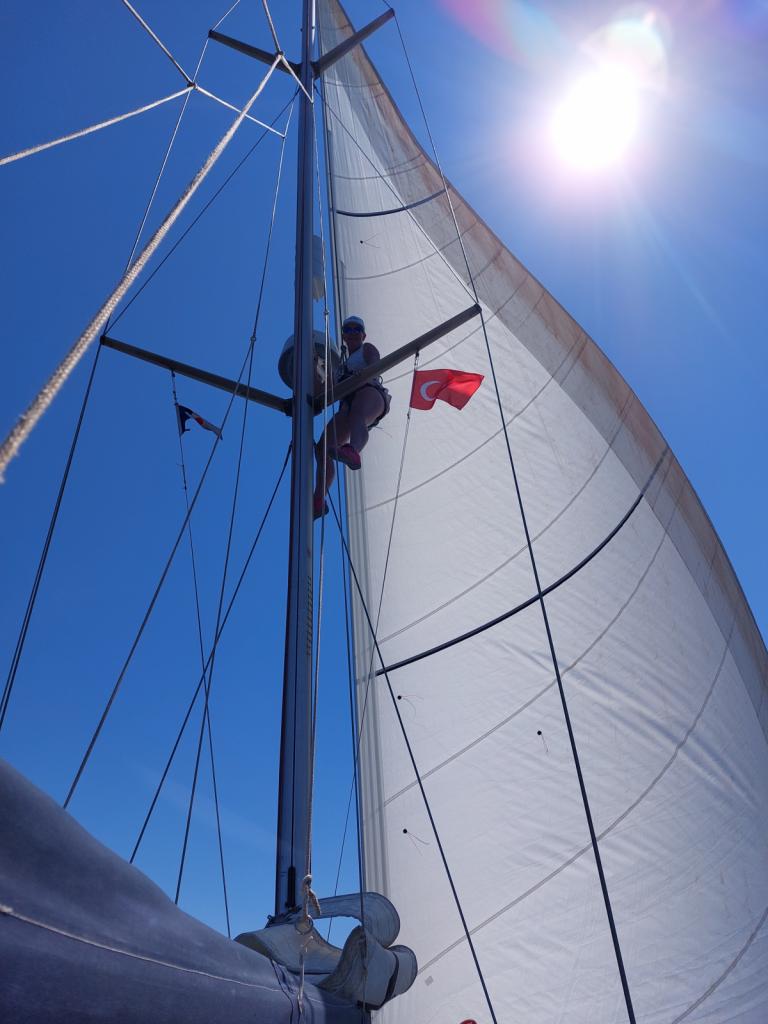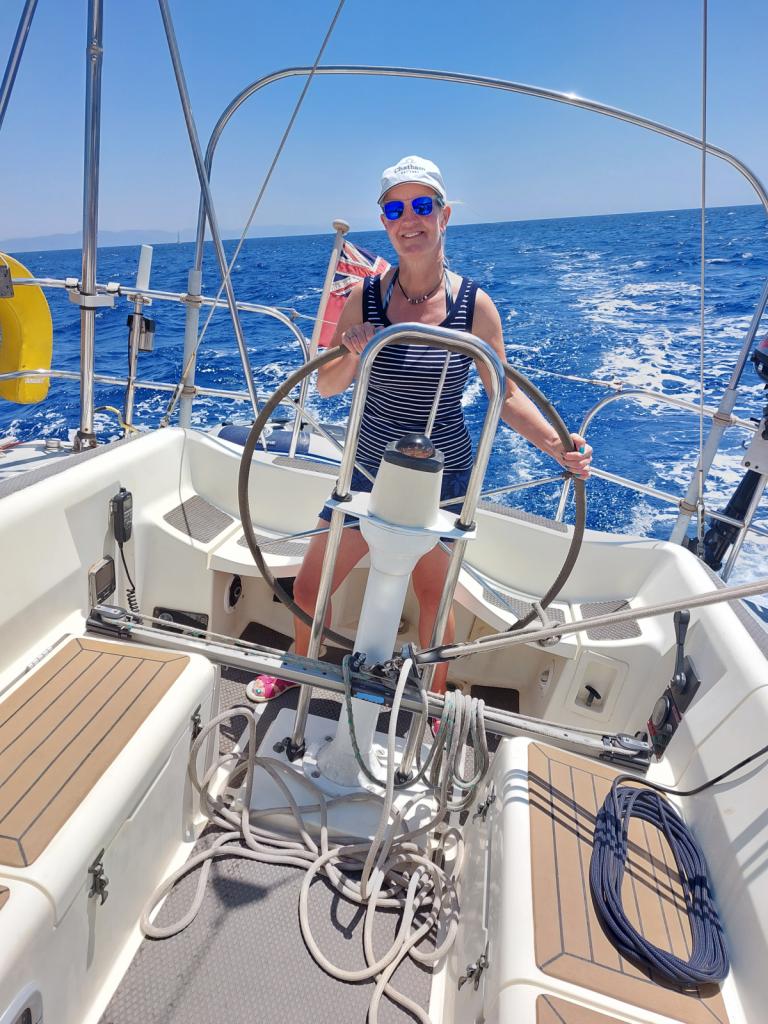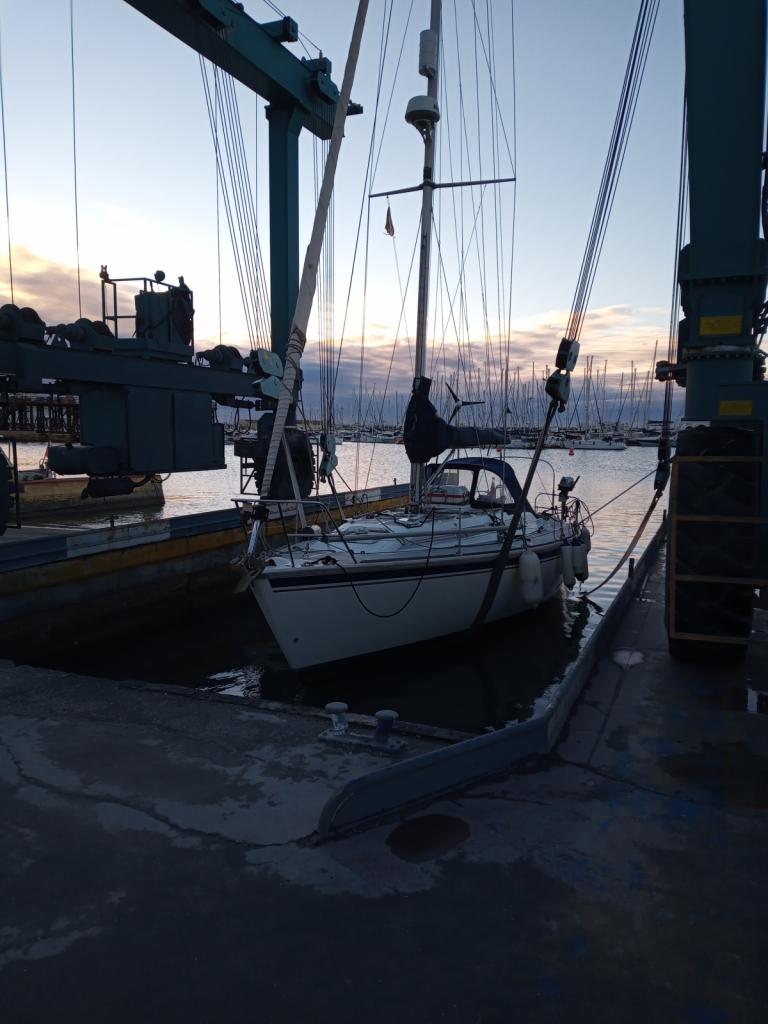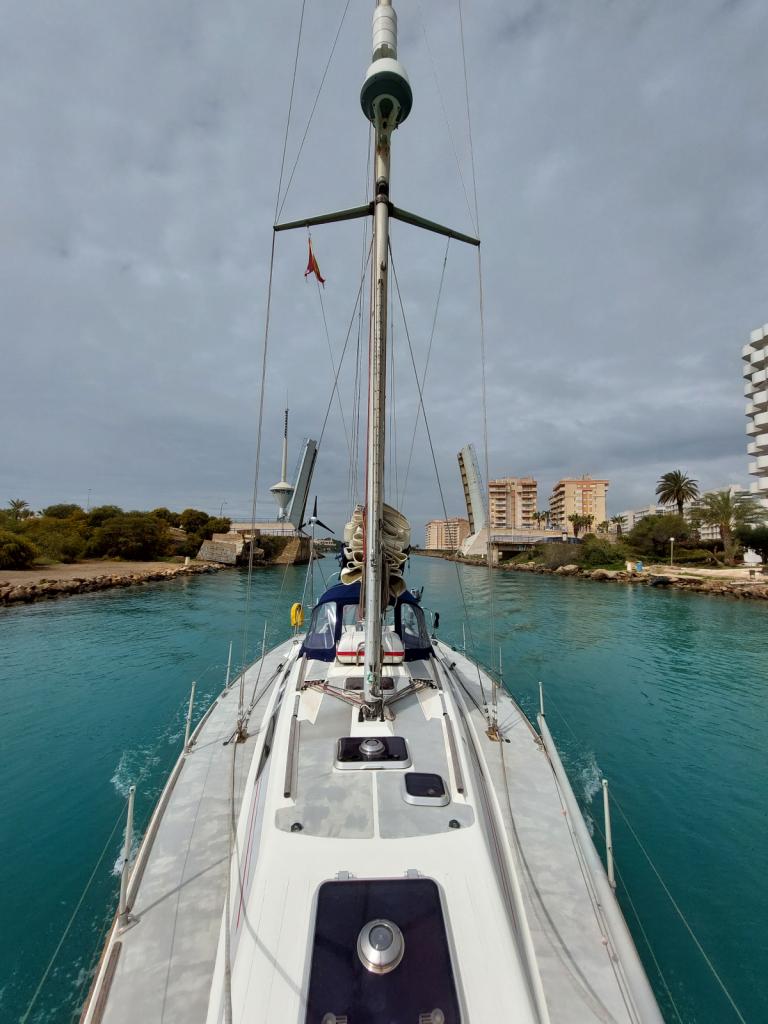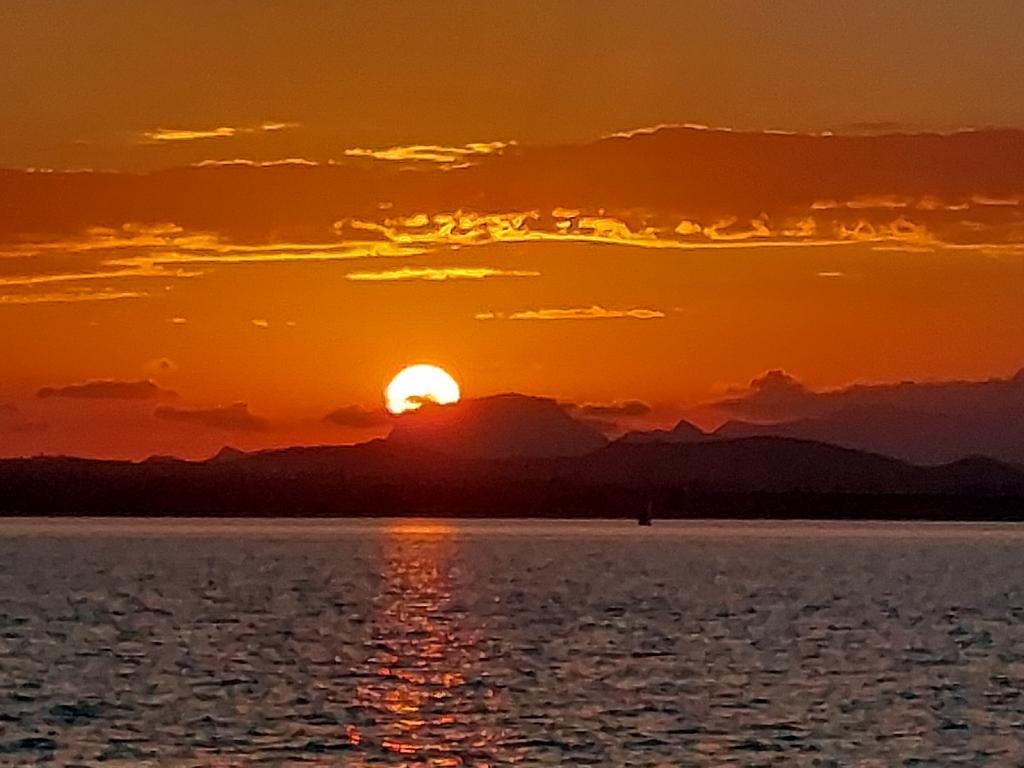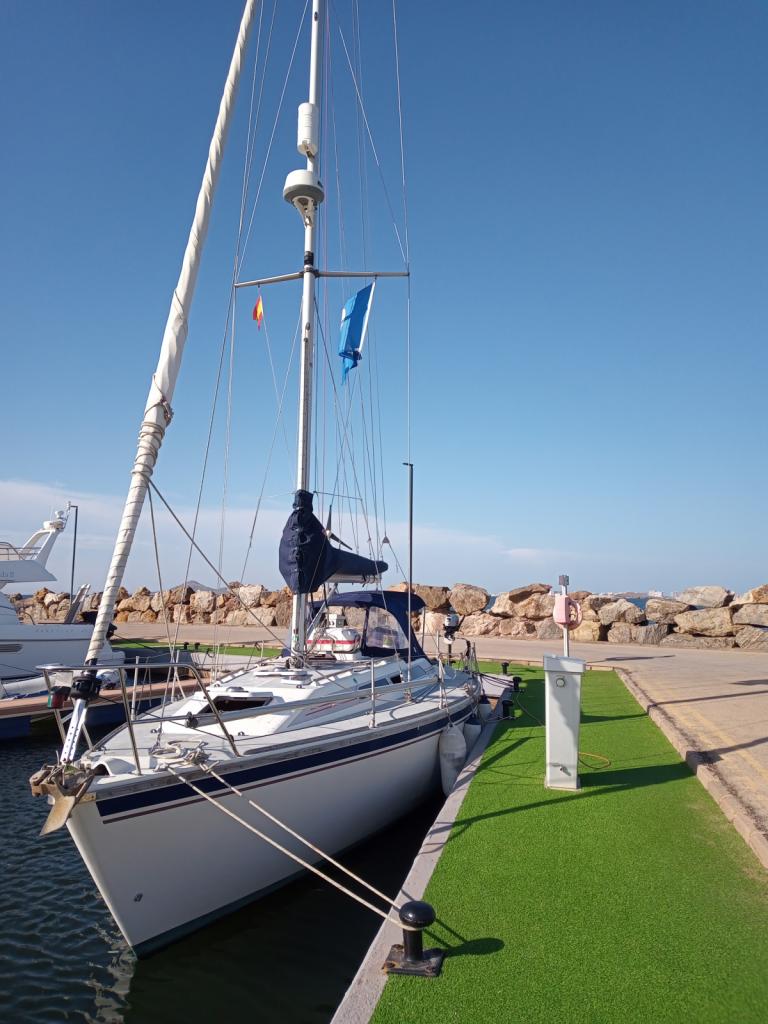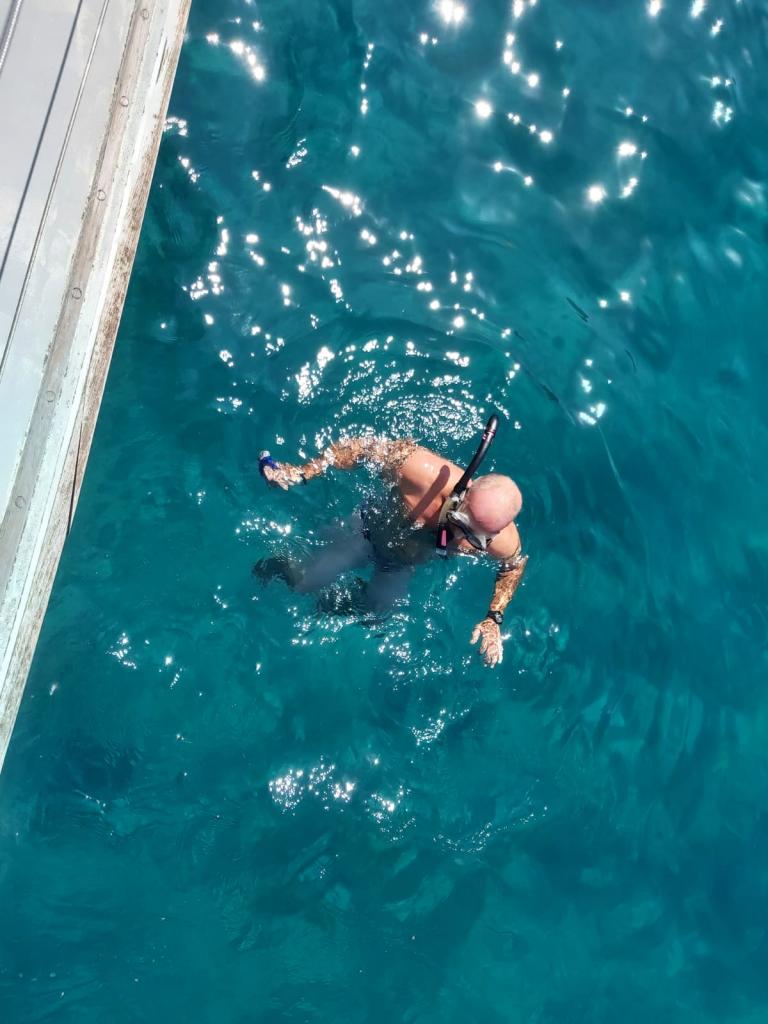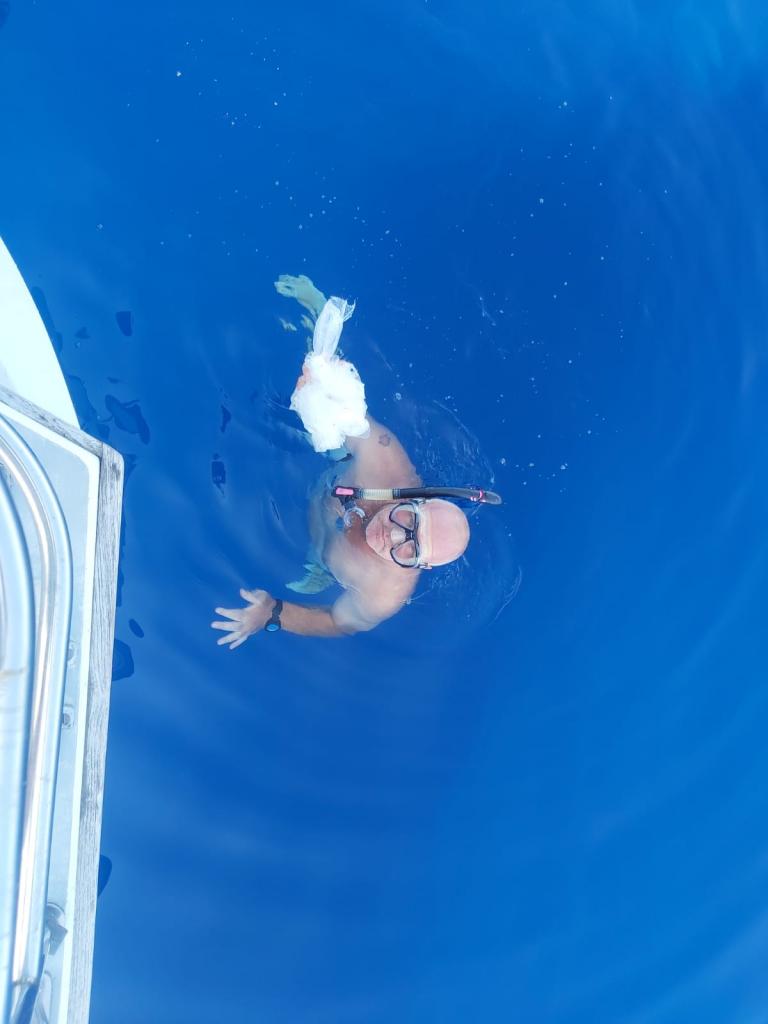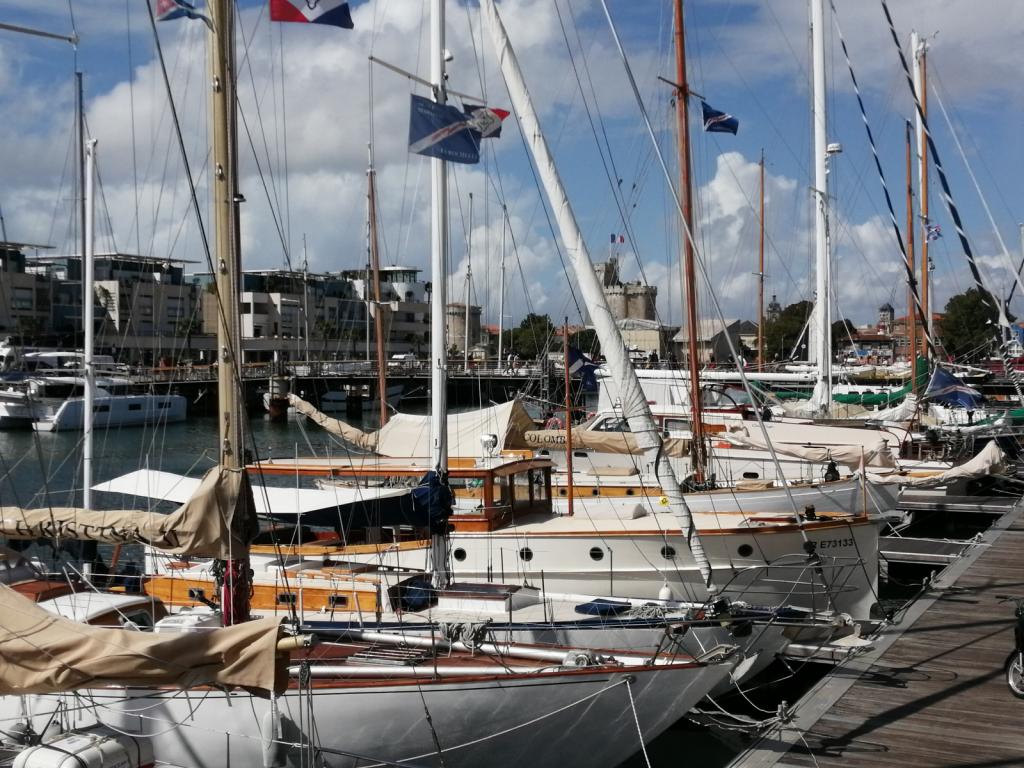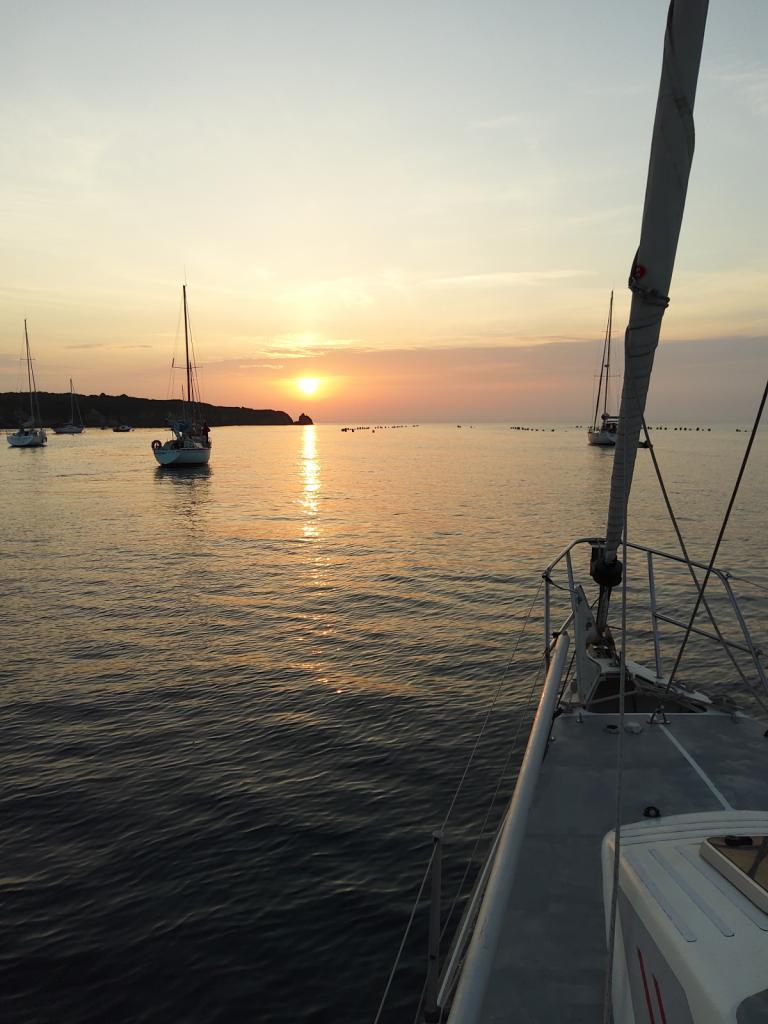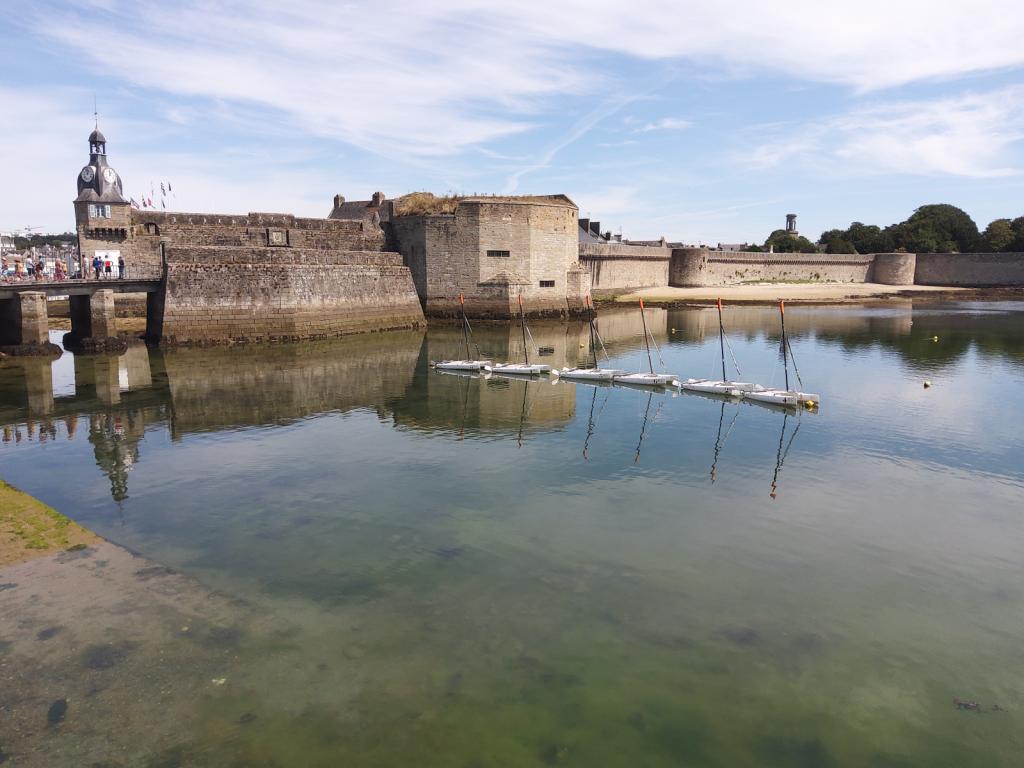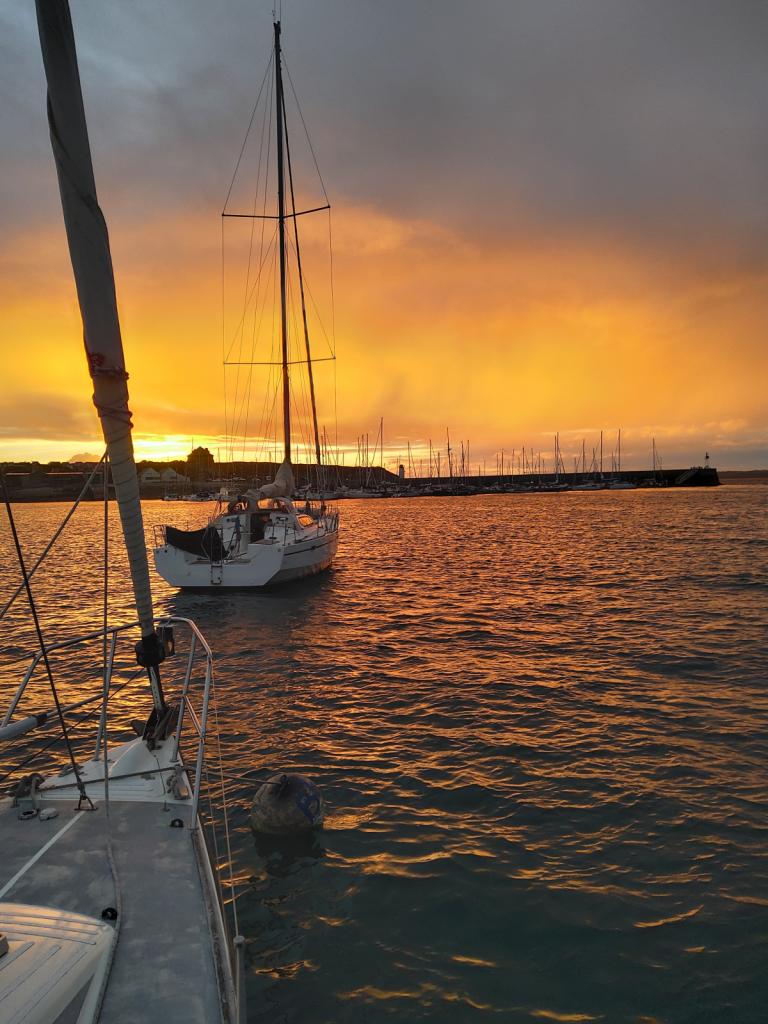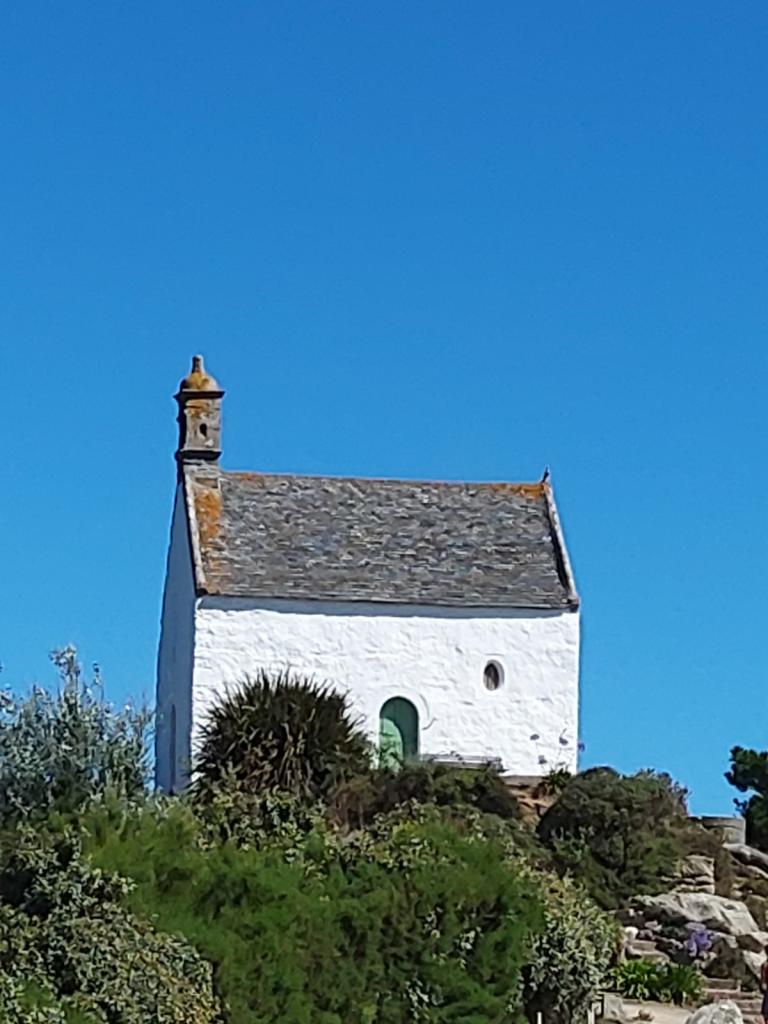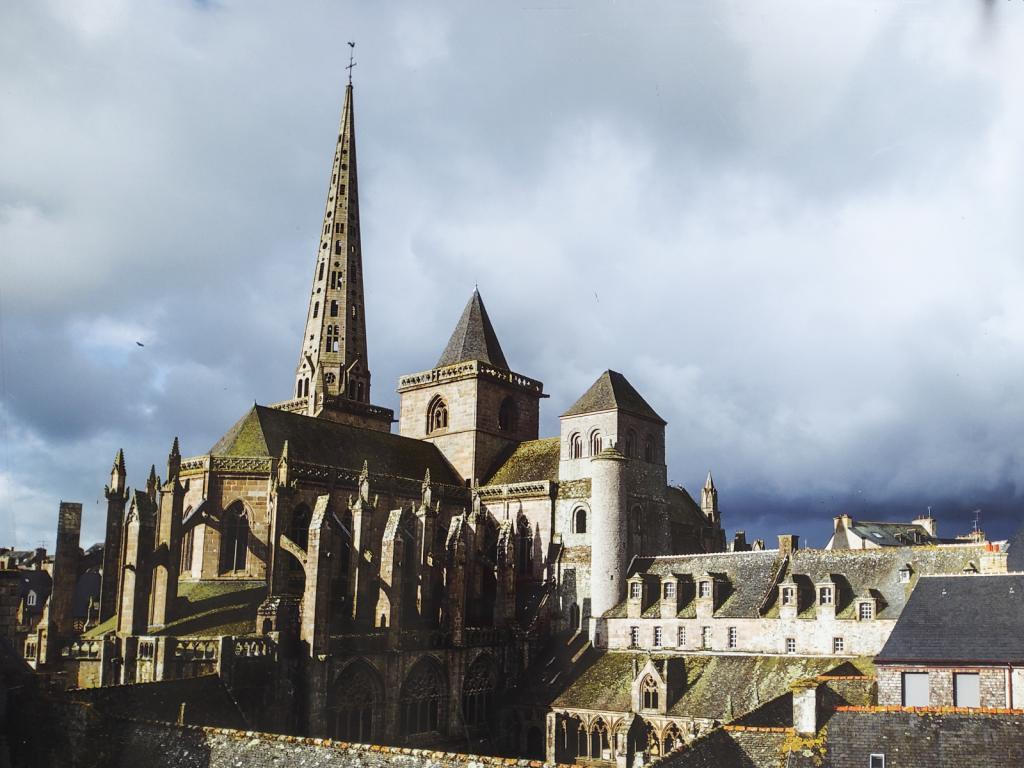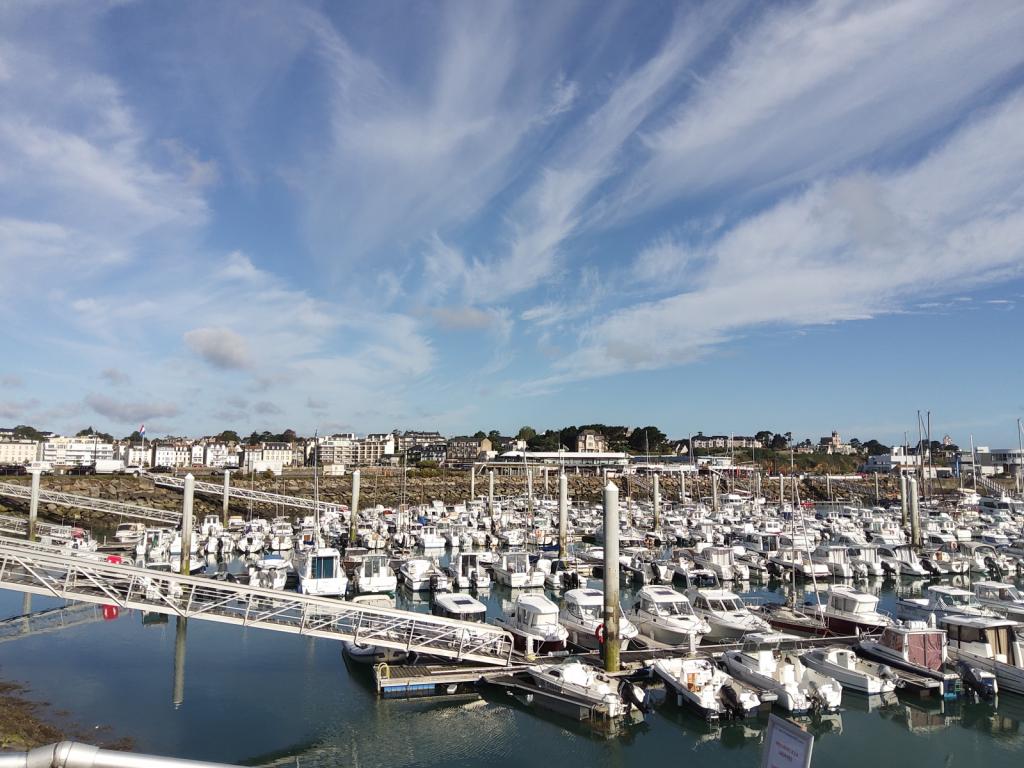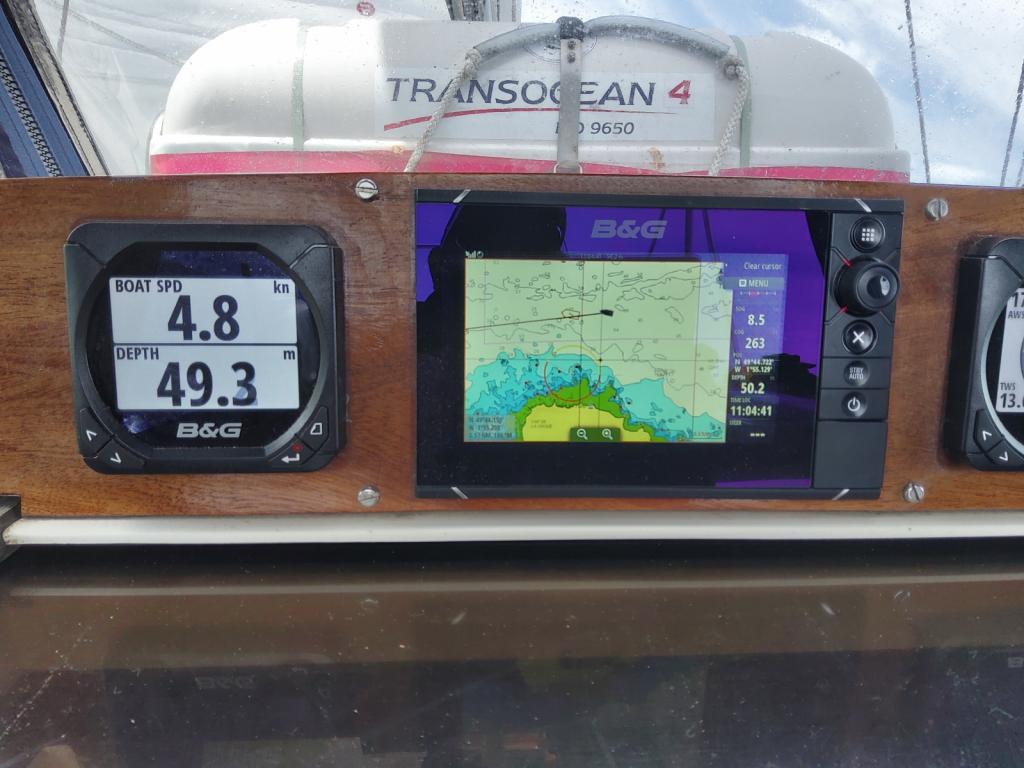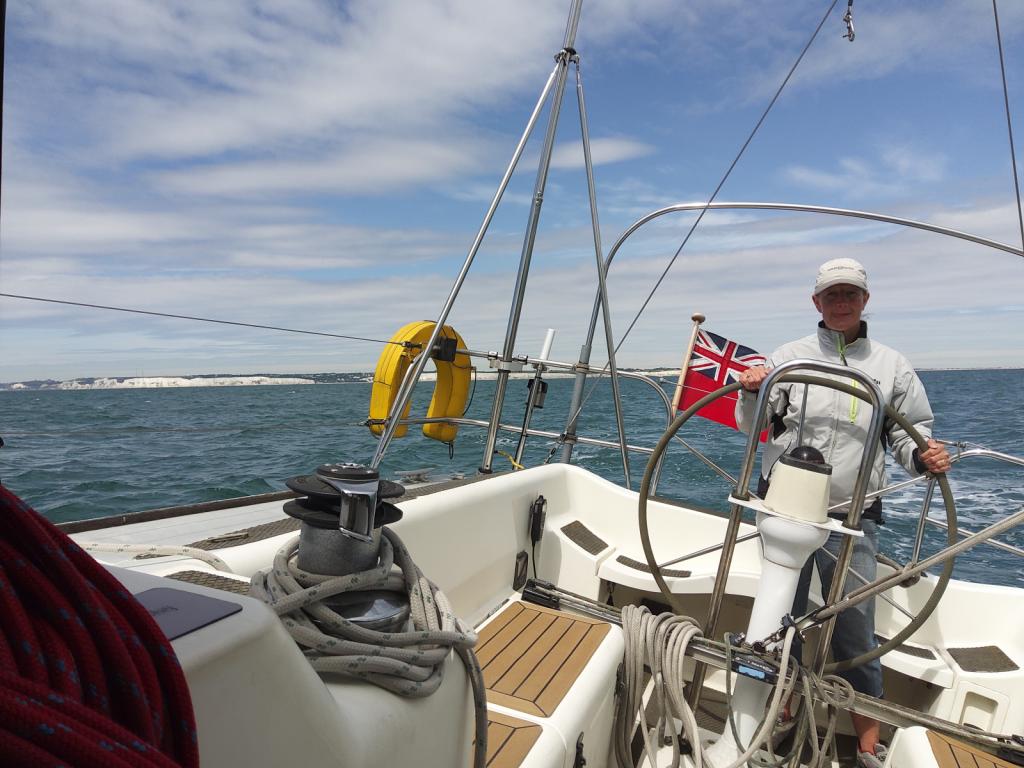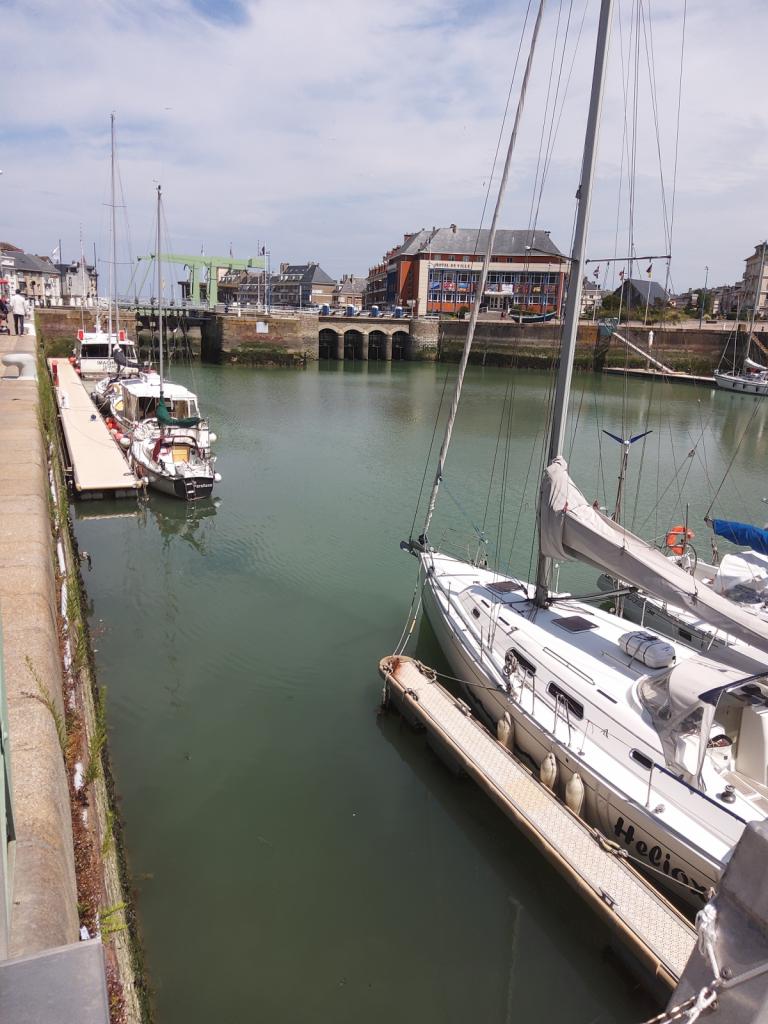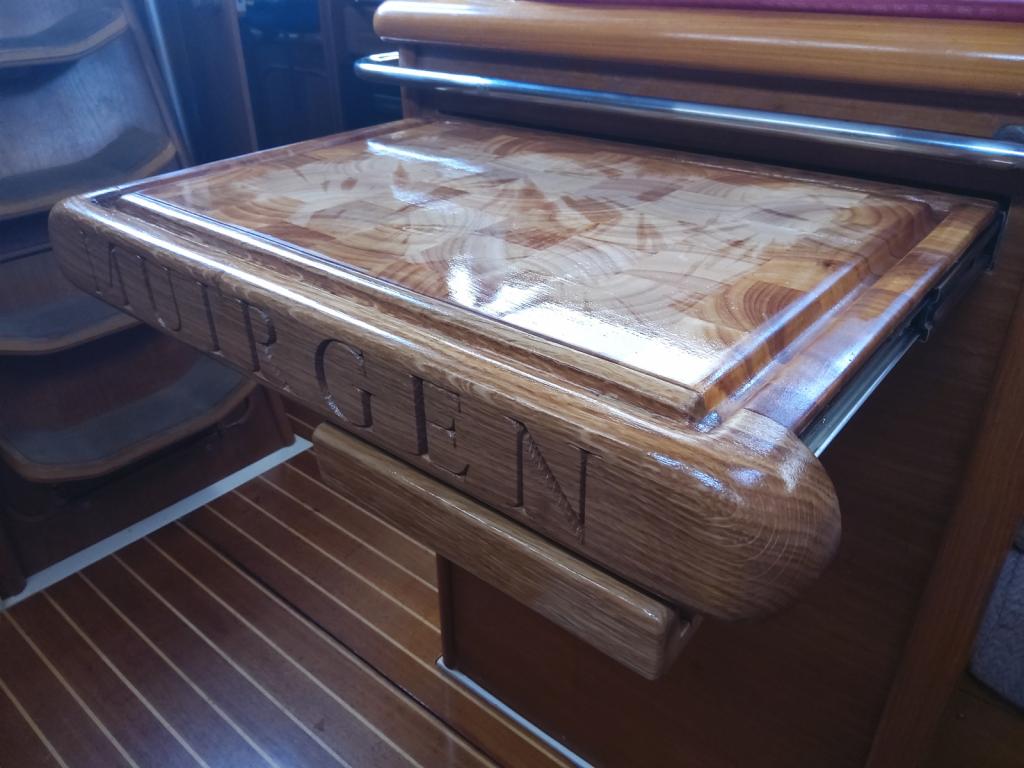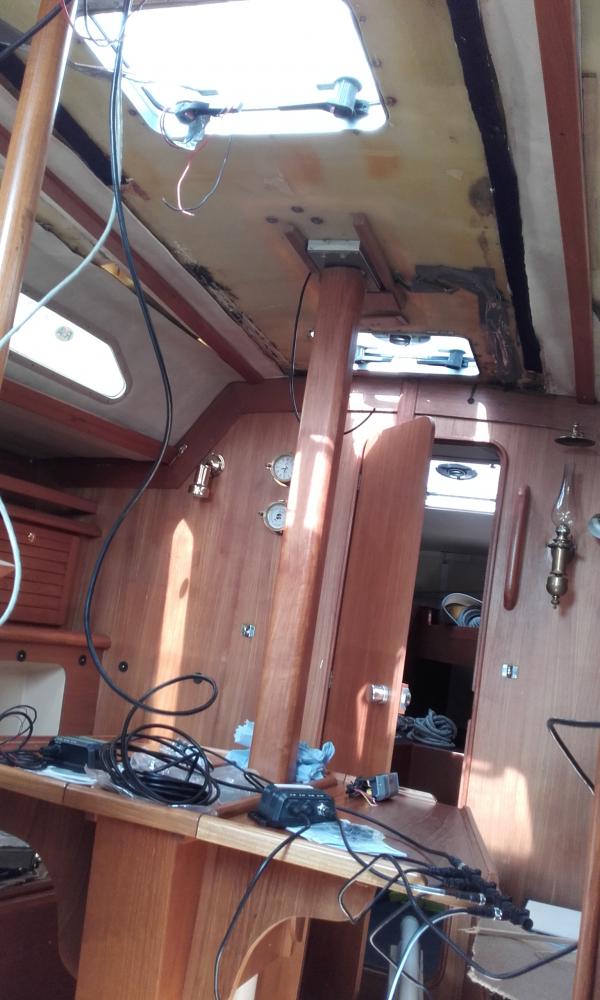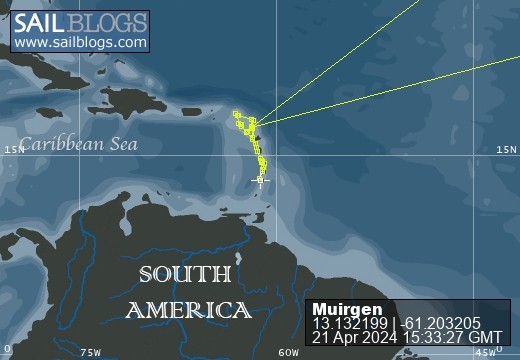
Born of the Sea
Preparing for a phased retirement on the sea. Muirgen (Gaelic for 'born of the sea')
15 April 2024 | Marigot Bay, Saint Lucia
08 April 2024 | Saint Lucia National Parks
06 April 2024 | Rodney Bay / Gros Islet, Saint Lucia
31 March 2024 | Sainte Anne, Martinique
25 March 2024 | Martinique
21 March 2024 | Dominica
19 March 2024 | Portsmouth, Dominica
13 March 2024 | Iles des Saintes
10 March 2024 | Deshaies, Guadeloupe
03 March 2024 | Monserrat to Guadeloupe
02 March 2024 | Monserrat
29 February 2024 | Nevis
27 February 2024 | St Kitts
24 February 2024
20 February 2024
17 February 2024 | Jolly Harbour, Antigua
09 February 2024
08 February 2024 | Guadeloupe and Iles des Saintes
18 January 2024 | Seaworth's Bluff, Antigua
09 January 2024 | Barbuda
Summer 2022 - Turkey - Bozuk Buku to Mersincik
19 July 2022
Donna Cariss
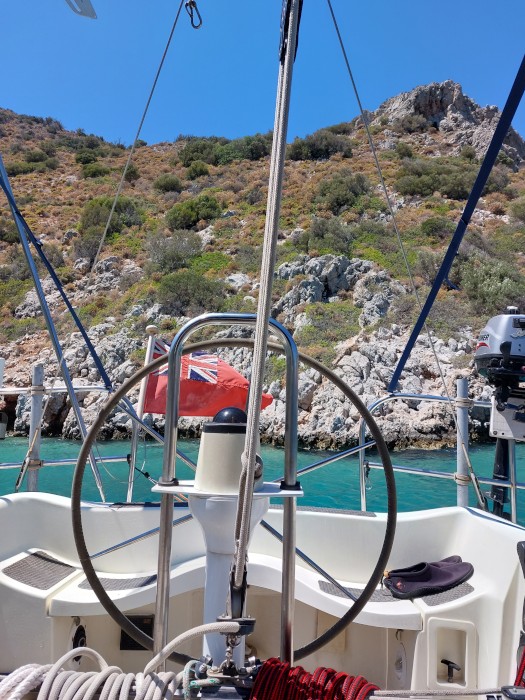
We had departed slightly later than planned and the breeze was already strong enough to sail. We put the main up in the sheltered bay and the foresail soon followed. We had to tack slightly southwards for a while but then on the port tack we made it passed the end of the peninsula. The wind was funnelling down between the peninsula and the Greek island of Symi, so we would be tacking back and forth, pinching up whenever we could. The wind direction and strength was variable, so we would definitely be helming, rather than using the autopilot, so we could sail as close to the wind as possible on each tack. Nobody else was sailing. Everyone else was motoring but we were enjoying the sail and weren't in a particular rush. After around four or five port and starboard tacks, we managed a final long one to round the top of the headland, as the wind direction was coming off the headland to bring us closer to a beam reach. Initially, as we crossed the gulf, we were heading to the south of the channel up to Bozburun but having given way to a few other yachts, coming towards us, we decided to head up towards the south coast of the Datca peninsula and nip through the very narrow and very shallow channel between the islands. We sailed all the way, dropping the sails just before the narrow channel. The wind was dying as we approached the coast and we could not safely pass through under sail, especially with traffic coming the other way. Having negotiated the channel, we turned south, exploring the anchoring opportunities for the next day. Being almost lunchtime, on a Friday, during the Turkish holidays, most of the available spots were already full, with everyone's long line tied to a convenient rock on shore. You are not supposed to tie to trees in Turkey. We rounded the island and made our way towards the harbour, which was surprisingly quiet. I had hoped for a berth on the east side, where we might pick up the WiFi from Osman's but we were called to a spot on the west side, between a yacht and a gullet. The guy on the yacht clapped when we had brought the boat in and tied up. He said it was a well-controlled and impressive team effort. We paid our dues for the night (250 TL / £12.50) and headed straight to the ATMs, of which there were around seven, around the square. Next we went to Osman's and gave him the cash for the Sailor's House. We opted to leave the provisioning until the following morning, other than grabbing some bottles of iced tea and beer. We decided to go for a walk along the beach but didn't go for a swim, as the water looked a bit murky, probably due to the number of boats at anchor in the bay. The beach was quiet and there wasn't much there, just a small hotel at the far end. We retraced our steps and relaxed on board, hiding from the sun under the canopy or down below. I noticed later that there was a wetsuit and stab jacket hung over the side of the yacht next to us. Chatting to the guy, it turned out he was a diving instructor and people charter his yacht to do diving courses. He had also been in the military, so he and Pete had a lot in common. I became gradually aware of a smell of diesel, coming and going but couldn't immediately see anything untoward, so initially ignored it. Then Pete came up and said he could smell it too. I looked over the side and there was a diesel slick on the water. The gullet had been running its engine and the diesel appeared to be coming from its exhaust. Pete sprayed washing up liquid into the water all around the boat, to try to disperse the diesel. It wasn't long before other boat owners started walking down the harbour side to see where the diesel was coming from. We pointed to the gullet. Someone alerted the harbour boys who also came to take a look. One of them went out in a dinghy with the guy from the yacht next to ours and sprayed detergent all over the harbour. It turned out that the gullet manager knew there was a problem but didn't seem to care and they appeared to get away with it. It was privately owned and the owner and his family were boarding that evening. We went for a shower and then to Osman's for tea. One of their cats took a fancy to Pete and settled down on his lap. We have seen some lovely cats in Turkey and very few strays. The Turks appear to love their cats and they are properly fed and watered. We chatted with an English couple, another Andrew and his wife, Susie. They had a 50 foot Jeanneau, moored just up from us.
The gullet at the side of us departed early next morning. We went off to do our shopping, visiting the grocer, the butcher, for mince and the Migros supermarket. We called into Osman's to say goodbye and ended up having breakfast, with Turkish tea. I had a delicious omelette and Pete had the Turkish scrambled eggs, called Menemen, which contains tomatoes, onions and peppers. It's named after a small town near Izmir. It looked like a big pile of mush but Pete said it was nice. We asked Rasaman to pack us up some of their homemade tzatziki as we hadn't managed to get any in the supermarket. Then we said our goodbyes to Osman, Yam Yam and Rasaman, promising to return in September. We returned to the boat and put the shopping away and started preparing to leave. Too late, they were bringing in another gullet alongside us. It was wider than the last one and the harbour boys insisted on us moving up closer to the other yacht. It was extremely tight and we ended up trapped in the middle, unable to get out. The gullet had several attempts at dropping his anchor and reversing in. They advised they were only there to change over their passengers and would be going at 1pm, so we settled down to wait. 1pm came and went, then it was 2pm and there was movement and then they departed, thankfully not pulling up our anchor. We were ready to go and followed them quickly, making our way towards the anchorages we had passed the previous day. We found a suitable spot, in around 8 metres of water, between a motor cruiser and a catamaran. The anchor held first time and Pete took two lines ashore. The water was beautiful and refreshing, in the afternoon sun. One of the boats was playing music, which was nice; something we had missed, with no mobile data to use Spotify. Other boats had children on board and it was good to hear them laughing in delight as they played in the water. A small motor boat pulled alongside, giving us a brochure for a very exclusive looking restaurant and spa, across the bay, telling us they could pick us up by boat if we called to make a reservation. We suspected it would be a bit outside our price range. Then we heard someone calling from another little boat. It was the ice cream man, so we called him over and bought Magnums; very enjoyable and refreshing. A racing cat sailed past us and we managed to get a couple of pictures (see Gallery). Pete cooked a chilli for tea and we had it with pasta, having realised we only had risotto rice left, not long grain or basmati. It was another lovely, lazy afternoon.
Next morning, we rose bright and early and headed out through the narrow channel again, before anyone else was moving. We motored along the coast, waiting for the wind to fill in a bit. We hadn't decided on a specific destination, just somewhere along the south coast of the Datca peninsula. We immediately passed close by a number of small coves, that two days before had been full of gullets but were now pretty empty and we noted them for the future. There were a lot of old ruins along the coast too. As we reached the end of the Bozburun mini peninsula, heading towards Symi, we passed very close to a rock, marked by a buoy. The water here is very deep and this rock pinnacle stands alone. Bizarre! The wind filled in and we put the sails up. Heading north west would be another beat but the wind was a comfortable strength. Looking east, the scenery looked spectacular and a beautiful area to explore but we didn't want to risk not making it to Oren in time for our flight home. We would later see some of these anchorages from the road, on our way to Dalaman airport and realise what we had missed. Perhaps next year. As we passed close to Symi again, we briefly picked up a Greek signal and our phones pinged with messages. I was at the helm and pinching up to the wind to see how far west we could get, while Pete consulted the pilot book and the chart plotter to see which anchorages looked the best. Kuruca Buku looked very picturesque, with a large seemingly sheltered bay, next to another Ciftlik. There was another anchorage in a bay just to the west, the two being divided by a promontory. The wind took us to Kuruca Buku, so we dropped the sails and motored in to explore. There were many yachts, catamarans and motor cruisers anchored off the beach, in the north west of the bay and on the west side, there was a gullet and another boat. This seemed much quieter, so we dropped anchor, reversed back and took a line ashore. Another yacht came in, with its mainsail billowing. It was in-mast furling and had jammed. They eventually dropped anchor and took a line ashore before attempting to tie the sail to the mast. Pete went to help. It was the first time the sailor's wife had been out on the boat, so it wasn't a good start. It was getting windy in the anchorage now and this yacht eventually moved towards the beach to find more shelter to try and fix their issue. The gullet and the other boat departed late afternoon, leaving us alone. The wind was blowing really strongly now and we weren't getting much shelter and the wind was onshore. Pete took the dinghy to see whether it was more sheltered further round the little bay, while I finished preparing dinner. He returned saying it was no better there. We had just dished up dinner when the anchor dragged and we were moving towards the shore quite quickly. We ditched the line tied to shore and started the engine and motored towards the anchor. Pete raised the anchor and then jumped in the dinghy to retrieve the long line, while I motored slowly up and down. Pete rowed back out to deep water and I picked him up and we headed towards the anchorage by the beach. It was really busy but we eventually found a gap big enough for us where the water was only about eight metres deep. Pete dropped the anchor while I helmed the boat, putting it in reverse to dig the anchor in. It held and we were able to eat our rapidly cooling tea while watching our transits, to ensure we weren't dragging. We watched the sun start to set over the hills, at which point the wind died down somewhat, so we jumped in the dinghy to row ashore for a quick beer at the 'camp site' by the beach. It was a bit rough and ready, with just a counter and a fridge and tables and chairs on the terrace but the beer was cold and they were playing classical music. By the time we were walking back along the beach to retrieve the dinghy, it was pitch black. We managed to pick out our anchor light from all the others and rowed back to the boat, by which time there was no wind at all and we could sleep easy.
We rose early again the following morning, to head west before the wind became too strong. The anchor came up without incident and I navigated my way slowly through all the yachts at anchor. As we left the bay, there were a couple of gullets anchored in a small inlet sheltered from the wind but the water here would have been too deep for us to anchor. 80 metres of chain would be useful in Turkey but I am not sure it would fit easily in the anchor locker. We already have an issue with the chain piling up and then jamming the windlass, with only 50 metres of chain. There was just enough wind to sail and it was very pleasant, sailing close to the shore for a while, having breakfast, before heading south west to cut across to a headland, south of Datca, the main town on this peninsula. There's a marina there but we were heading for Palamut, named after the small tuna in this area. Pete put a long fishing line out behind us, in the hope of catching dinner but to no avail. There was a steady stream of yachts leaving Datca but they were all heading east. We expected that the wind would pick up as we approached the headland but it did the opposite and died completely, so down came the sails and we continued on our way under engine. Now there were a few yachts coming towards us, giving us hope that we might get into the small harbour at Palamut. It was supposed to be shallow, so we surmised that larger yachts and catamarans may struggle, leaving space for us. There were boats manoeuvring in the harbour so we circled round, along with another British yacht. We asked them if they knew whether it was lazy lines or anchor; they thought there were some lazy lines but mostly use of your own anchor, so we prepared. We watched, in disbelief, as a snorkeller passed straight across the harbour entrance, risking life and limb. Having waited our turn, we entered the harbour and a man in a white cowboy hat shouted at us that there was no room and that the remaining space, alongside the other British yacht, was already booked for a regular visitor. We turned around and he shouted again that a boat on the outside wall was going to leave and we should wait just outside the harbour. It was a small fishing boat that moved, obviously told to make way for paying guests. I dropped the anchor and Pete reversed up towards the harbour wall, alongside another yacht. We needed reasonably long lines as there were rocks sloping down from the harbour wall. We put the dinghy in the gap so we could climb ashore. We walked across the harbour side to speak to the British couple, Alan and Maggie, who invited us on board and then we all decided to head into town for a cold one. They were travelling on a budget, even more so than ourselves, as they were retired and only had state pension coming in. They lived in Spain, near the Mar Menor but the opposite end to where Muirgen had been moored last Winter. We swapped stories and knowledge and then they went in search of a supermarket and we went to find some Wi-Fi. We found some but it was barely enough to send a message, let alone support a call. We stocked up on drinks and headed back to the boat. The wind had got up and created some swell and the dinghy was scraping up and down the back of the boat. We got on board and decided to leave the berth and look for somewhere to anchor instead. The pilot book and the chart showed an anchorage by Cay Limani, not too far to the south west. We went for a look but it was already full with a couple of gullets and a yacht. The inlet slightly north was worth a look but the only area shallow enough to anchor required us to almost back into a cave; too risky with the wind due to get up overnight. Having discussed our options, we decided to return to Palamut and anchor off the beach, where we could get plenty of chain out and the wind would be offshore. We went as close to the line of swimming buoys as we could and dropped the anchor with 4 metres of water under the keel and let out a good 40 metres of chain. The anchor dug in as I reversed and held firm. By the end of the night it would be a struggle to lift. We settled in the cockpit to watch as more and more yachts joined us at anchor off the beach and swimmers continued to ignore the safe area markers. A yacht arrived and decided to drop anchor immediately in front of the harbour entrance, where it would not only impede traffic but would hit the rocks when the wind turned. The anchor didn't hold so they moved south of the harbour, looking for a safe place to anchor in the beautiful little bay, not thinking about why nobody else was anchored there. They made a swift exit after nearly hitting the well-documented reef. They returned to the beach and had several more attempts to anchor but their technique was all wrong; dropping the anchor while stationary. Now we weren't the only ones watching. The men on the charter yacht beside us were also watching. They decided to go ashore and stopped by the yacht to talk and one man on the yacht seemed to wave to Pete to come over, so he duly rowed the dinghy over, only to be told to mind his own business. Eventually, they anchored and everyone breathed a sigh of relief. By late evening, the wind was really howling. Pete went to bed and I sat in the cockpit ensuring that weren't dragging. Eventually though I also went to bed but I wasn't able to sleep. I was variously listening to the wind and to the throb of music coming from the bars along the front. You could tell when the boat swung, by how loud the music was. It was relatively quiet when we were facing the shore and very loud when sitting parallel to the beach. With the swinging, I got up a couple of times to check our position and then, eventually, Pete got up and sat in the cockpit for a while. Nobody was dragging their anchor, so we settled back down and went to sleep.
The next morning it was still pretty windy but we departed as planned, getting the sails up with a couple of reefs in. The wind strength and direction was all over the place as we headed alongside the cliffs. After getting caught in a lull and being bounced by the waves, we decided to drop the sails and motor, as we were mostly heading in the wrong direction when we had wind and going nowhere when we didn't. It was frustrating. Other yachts were travelling in the opposite direction, having left Knidos, just under the south western side of the headland but there were only motor boats going west. When we rounded the headland, to head north, then north east, between the Turkish mainland and Kos, the swell became quite vicious and uncomfortable and we weren't making very much headway, so we increased the engine revs to 2200. It would cost more in fuel but it would be worth it and the engine could do with a bit of a workout. The boat was rocking from side to side and anything that wasn't secured, down below, was now on the floor, including the charts and log book. I was sitting on the cockpit seat and bracing myself with my feet against the seat on the other side and an arm around a winch. My legs are a couple of inches too short to reach comfortably. I had hoped, as we headed further round the peninsula, that the swell would ease but the strong winds had built it up and funnelling it through the narrow gap to the east of Kos. We kept changing our minds about whether to head the 15 miles over to the south side of the Bodrum peninsula or head to a hopefully sheltered anchorage a few miles to the east. I decided that I didn't want another 3-4 hours of rocking so we headed for the anchorage. We could see a couple of gullets heading there too but they had come from the north, so were having an easier time with the swell behind them. Pete started to worry that the anchorage would be full and it seemed to take an age to get to the channel between the small headland and an even smaller island. As soon as we passed through the channel, the swell eased and we breathed a sigh of relief. We had arrived at Mersincik. The very sheltered looking bay, directly round the headland, was full - a gullet, a smaller family gullet type boat and a catamaran, so we headed south to the south west corner of the larger bay, where there was already a small yacht at anchor. We dropped the anchor and Pete took a long line ashore, securing us to a rock in the water. It wasn't long before a large privately owned motor cruiser arrived, complete with crew. They decided to squeeze into the small gap between us and the other yacht, which was swinging at anchor. I was nervous as the crew buggered about trying to secure their long lines, as the wind was blowing a bit in here. Eventually they were settled and another yacht arrived, anchoring a bit further north. Pete and I jumped in the dinghy and went to explore along the beach and then rowed up to the smaller anchorage. The catamaran had gone. We dashed back to the boat, lifted the anchor and moved to the more sheltered bay. The water was shallow but we only draw 1.53m so it was deep enough for us. Again, Pete took long lines ashore, 2 this time, while I fed them out and then tightened them once he had secured them around rocks. We had a swim; the water was deliciously cool then Pete went ashore in the dinghy. He decided, as the wind was due to blow hard for the next 2 days, to put the kedge anchor out on the starboard side. Now we were really secure. More yachts were arriving, to escape the swell and the forecast strong winds. One squeezed in on the top side of the gullet, a really tight space and another came to look at the space between us and the shore, exclaiming about us having the kedge out, preventing anyone else from coming in. Pete tried to explain that the water was too shallow anyone and there were large rocks under the surface but the man, an American, wasn't appeased. They backed out and then came in for a closer look in the dinghy, complaining again but we weren't giving in and creating a situation that would be dangerous for us and for them. The afternoon sun was scorching, so frequent dips were needed until the sun eventually dipped behind the hilltop. No sooner had this happened then the wasps came out and they seemed to be targeting our boat, perhaps due to the red / black and red / yellow striped lines we were using for the long lines and the kedge, but we now knew how to deal with this; Tim's best ground coffee! We soon had that alight at the top of the companion way and the wasps that were flying into the cockpit were doing an abrupt turn. It was now lovely, sitting in the cockpit, reading a book and sipping a glass of cool white wine, while Pete prepared dinner.
Next morning, I was up and about around 8am, with Pete lingering an hour or so longer in bed. As he came round, I said I thought we could have set sail again today, as the swell didn't look too bad now but Pete said we should have left earlier if that's what we were going to do, so we agreed to stay another night, as originally planned. To be honest, it was only the prevalence of wasps that made me want to leave, as the anchorage was idyllic and quiet. The gullet had left, so there was only us, the small yacht and the little gullet with a family on board. Every so often, I kept getting a whiff of something burning but looking round the boat I couldn't see anything obvious and nobody else seemed to be concerned. I also had the impression that I was getting slightly wet from time to time, which was strange. It wasn't long though before we saw a helicopter, trailing a large water bucket and then we could see a smoky haze above the hills surrounding the anchorage. There was a forest fire someone over the ridge. The helicopter was quite a spectacle, as it repeatedly returned to pick up water from the sea, just at the end of the headland where we were anchored, presumably because the wind and water were calm there, in the lea of the little island. Each time, it would hover, the descend until the bucket was in the water, rise again with it full, before turning to fly around the anchorage and drop its load just over the ridge. There were also a couple of sea planes and eventually a chinook taking part in the fire fighting. It was a disaster but interesting to observe. This went on all afternoon until dusk. We had to light the coffee again to keep the wasps away and eventually closed up and had an early night, as we planned to leave by 7am latest next morning, providing the sea state had calmed again.
The gullet at the side of us departed early next morning. We went off to do our shopping, visiting the grocer, the butcher, for mince and the Migros supermarket. We called into Osman's to say goodbye and ended up having breakfast, with Turkish tea. I had a delicious omelette and Pete had the Turkish scrambled eggs, called Menemen, which contains tomatoes, onions and peppers. It's named after a small town near Izmir. It looked like a big pile of mush but Pete said it was nice. We asked Rasaman to pack us up some of their homemade tzatziki as we hadn't managed to get any in the supermarket. Then we said our goodbyes to Osman, Yam Yam and Rasaman, promising to return in September. We returned to the boat and put the shopping away and started preparing to leave. Too late, they were bringing in another gullet alongside us. It was wider than the last one and the harbour boys insisted on us moving up closer to the other yacht. It was extremely tight and we ended up trapped in the middle, unable to get out. The gullet had several attempts at dropping his anchor and reversing in. They advised they were only there to change over their passengers and would be going at 1pm, so we settled down to wait. 1pm came and went, then it was 2pm and there was movement and then they departed, thankfully not pulling up our anchor. We were ready to go and followed them quickly, making our way towards the anchorages we had passed the previous day. We found a suitable spot, in around 8 metres of water, between a motor cruiser and a catamaran. The anchor held first time and Pete took two lines ashore. The water was beautiful and refreshing, in the afternoon sun. One of the boats was playing music, which was nice; something we had missed, with no mobile data to use Spotify. Other boats had children on board and it was good to hear them laughing in delight as they played in the water. A small motor boat pulled alongside, giving us a brochure for a very exclusive looking restaurant and spa, across the bay, telling us they could pick us up by boat if we called to make a reservation. We suspected it would be a bit outside our price range. Then we heard someone calling from another little boat. It was the ice cream man, so we called him over and bought Magnums; very enjoyable and refreshing. A racing cat sailed past us and we managed to get a couple of pictures (see Gallery). Pete cooked a chilli for tea and we had it with pasta, having realised we only had risotto rice left, not long grain or basmati. It was another lovely, lazy afternoon.
Next morning, we rose bright and early and headed out through the narrow channel again, before anyone else was moving. We motored along the coast, waiting for the wind to fill in a bit. We hadn't decided on a specific destination, just somewhere along the south coast of the Datca peninsula. We immediately passed close by a number of small coves, that two days before had been full of gullets but were now pretty empty and we noted them for the future. There were a lot of old ruins along the coast too. As we reached the end of the Bozburun mini peninsula, heading towards Symi, we passed very close to a rock, marked by a buoy. The water here is very deep and this rock pinnacle stands alone. Bizarre! The wind filled in and we put the sails up. Heading north west would be another beat but the wind was a comfortable strength. Looking east, the scenery looked spectacular and a beautiful area to explore but we didn't want to risk not making it to Oren in time for our flight home. We would later see some of these anchorages from the road, on our way to Dalaman airport and realise what we had missed. Perhaps next year. As we passed close to Symi again, we briefly picked up a Greek signal and our phones pinged with messages. I was at the helm and pinching up to the wind to see how far west we could get, while Pete consulted the pilot book and the chart plotter to see which anchorages looked the best. Kuruca Buku looked very picturesque, with a large seemingly sheltered bay, next to another Ciftlik. There was another anchorage in a bay just to the west, the two being divided by a promontory. The wind took us to Kuruca Buku, so we dropped the sails and motored in to explore. There were many yachts, catamarans and motor cruisers anchored off the beach, in the north west of the bay and on the west side, there was a gullet and another boat. This seemed much quieter, so we dropped anchor, reversed back and took a line ashore. Another yacht came in, with its mainsail billowing. It was in-mast furling and had jammed. They eventually dropped anchor and took a line ashore before attempting to tie the sail to the mast. Pete went to help. It was the first time the sailor's wife had been out on the boat, so it wasn't a good start. It was getting windy in the anchorage now and this yacht eventually moved towards the beach to find more shelter to try and fix their issue. The gullet and the other boat departed late afternoon, leaving us alone. The wind was blowing really strongly now and we weren't getting much shelter and the wind was onshore. Pete took the dinghy to see whether it was more sheltered further round the little bay, while I finished preparing dinner. He returned saying it was no better there. We had just dished up dinner when the anchor dragged and we were moving towards the shore quite quickly. We ditched the line tied to shore and started the engine and motored towards the anchor. Pete raised the anchor and then jumped in the dinghy to retrieve the long line, while I motored slowly up and down. Pete rowed back out to deep water and I picked him up and we headed towards the anchorage by the beach. It was really busy but we eventually found a gap big enough for us where the water was only about eight metres deep. Pete dropped the anchor while I helmed the boat, putting it in reverse to dig the anchor in. It held and we were able to eat our rapidly cooling tea while watching our transits, to ensure we weren't dragging. We watched the sun start to set over the hills, at which point the wind died down somewhat, so we jumped in the dinghy to row ashore for a quick beer at the 'camp site' by the beach. It was a bit rough and ready, with just a counter and a fridge and tables and chairs on the terrace but the beer was cold and they were playing classical music. By the time we were walking back along the beach to retrieve the dinghy, it was pitch black. We managed to pick out our anchor light from all the others and rowed back to the boat, by which time there was no wind at all and we could sleep easy.
We rose early again the following morning, to head west before the wind became too strong. The anchor came up without incident and I navigated my way slowly through all the yachts at anchor. As we left the bay, there were a couple of gullets anchored in a small inlet sheltered from the wind but the water here would have been too deep for us to anchor. 80 metres of chain would be useful in Turkey but I am not sure it would fit easily in the anchor locker. We already have an issue with the chain piling up and then jamming the windlass, with only 50 metres of chain. There was just enough wind to sail and it was very pleasant, sailing close to the shore for a while, having breakfast, before heading south west to cut across to a headland, south of Datca, the main town on this peninsula. There's a marina there but we were heading for Palamut, named after the small tuna in this area. Pete put a long fishing line out behind us, in the hope of catching dinner but to no avail. There was a steady stream of yachts leaving Datca but they were all heading east. We expected that the wind would pick up as we approached the headland but it did the opposite and died completely, so down came the sails and we continued on our way under engine. Now there were a few yachts coming towards us, giving us hope that we might get into the small harbour at Palamut. It was supposed to be shallow, so we surmised that larger yachts and catamarans may struggle, leaving space for us. There were boats manoeuvring in the harbour so we circled round, along with another British yacht. We asked them if they knew whether it was lazy lines or anchor; they thought there were some lazy lines but mostly use of your own anchor, so we prepared. We watched, in disbelief, as a snorkeller passed straight across the harbour entrance, risking life and limb. Having waited our turn, we entered the harbour and a man in a white cowboy hat shouted at us that there was no room and that the remaining space, alongside the other British yacht, was already booked for a regular visitor. We turned around and he shouted again that a boat on the outside wall was going to leave and we should wait just outside the harbour. It was a small fishing boat that moved, obviously told to make way for paying guests. I dropped the anchor and Pete reversed up towards the harbour wall, alongside another yacht. We needed reasonably long lines as there were rocks sloping down from the harbour wall. We put the dinghy in the gap so we could climb ashore. We walked across the harbour side to speak to the British couple, Alan and Maggie, who invited us on board and then we all decided to head into town for a cold one. They were travelling on a budget, even more so than ourselves, as they were retired and only had state pension coming in. They lived in Spain, near the Mar Menor but the opposite end to where Muirgen had been moored last Winter. We swapped stories and knowledge and then they went in search of a supermarket and we went to find some Wi-Fi. We found some but it was barely enough to send a message, let alone support a call. We stocked up on drinks and headed back to the boat. The wind had got up and created some swell and the dinghy was scraping up and down the back of the boat. We got on board and decided to leave the berth and look for somewhere to anchor instead. The pilot book and the chart showed an anchorage by Cay Limani, not too far to the south west. We went for a look but it was already full with a couple of gullets and a yacht. The inlet slightly north was worth a look but the only area shallow enough to anchor required us to almost back into a cave; too risky with the wind due to get up overnight. Having discussed our options, we decided to return to Palamut and anchor off the beach, where we could get plenty of chain out and the wind would be offshore. We went as close to the line of swimming buoys as we could and dropped the anchor with 4 metres of water under the keel and let out a good 40 metres of chain. The anchor dug in as I reversed and held firm. By the end of the night it would be a struggle to lift. We settled in the cockpit to watch as more and more yachts joined us at anchor off the beach and swimmers continued to ignore the safe area markers. A yacht arrived and decided to drop anchor immediately in front of the harbour entrance, where it would not only impede traffic but would hit the rocks when the wind turned. The anchor didn't hold so they moved south of the harbour, looking for a safe place to anchor in the beautiful little bay, not thinking about why nobody else was anchored there. They made a swift exit after nearly hitting the well-documented reef. They returned to the beach and had several more attempts to anchor but their technique was all wrong; dropping the anchor while stationary. Now we weren't the only ones watching. The men on the charter yacht beside us were also watching. They decided to go ashore and stopped by the yacht to talk and one man on the yacht seemed to wave to Pete to come over, so he duly rowed the dinghy over, only to be told to mind his own business. Eventually, they anchored and everyone breathed a sigh of relief. By late evening, the wind was really howling. Pete went to bed and I sat in the cockpit ensuring that weren't dragging. Eventually though I also went to bed but I wasn't able to sleep. I was variously listening to the wind and to the throb of music coming from the bars along the front. You could tell when the boat swung, by how loud the music was. It was relatively quiet when we were facing the shore and very loud when sitting parallel to the beach. With the swinging, I got up a couple of times to check our position and then, eventually, Pete got up and sat in the cockpit for a while. Nobody was dragging their anchor, so we settled back down and went to sleep.
The next morning it was still pretty windy but we departed as planned, getting the sails up with a couple of reefs in. The wind strength and direction was all over the place as we headed alongside the cliffs. After getting caught in a lull and being bounced by the waves, we decided to drop the sails and motor, as we were mostly heading in the wrong direction when we had wind and going nowhere when we didn't. It was frustrating. Other yachts were travelling in the opposite direction, having left Knidos, just under the south western side of the headland but there were only motor boats going west. When we rounded the headland, to head north, then north east, between the Turkish mainland and Kos, the swell became quite vicious and uncomfortable and we weren't making very much headway, so we increased the engine revs to 2200. It would cost more in fuel but it would be worth it and the engine could do with a bit of a workout. The boat was rocking from side to side and anything that wasn't secured, down below, was now on the floor, including the charts and log book. I was sitting on the cockpit seat and bracing myself with my feet against the seat on the other side and an arm around a winch. My legs are a couple of inches too short to reach comfortably. I had hoped, as we headed further round the peninsula, that the swell would ease but the strong winds had built it up and funnelling it through the narrow gap to the east of Kos. We kept changing our minds about whether to head the 15 miles over to the south side of the Bodrum peninsula or head to a hopefully sheltered anchorage a few miles to the east. I decided that I didn't want another 3-4 hours of rocking so we headed for the anchorage. We could see a couple of gullets heading there too but they had come from the north, so were having an easier time with the swell behind them. Pete started to worry that the anchorage would be full and it seemed to take an age to get to the channel between the small headland and an even smaller island. As soon as we passed through the channel, the swell eased and we breathed a sigh of relief. We had arrived at Mersincik. The very sheltered looking bay, directly round the headland, was full - a gullet, a smaller family gullet type boat and a catamaran, so we headed south to the south west corner of the larger bay, where there was already a small yacht at anchor. We dropped the anchor and Pete took a long line ashore, securing us to a rock in the water. It wasn't long before a large privately owned motor cruiser arrived, complete with crew. They decided to squeeze into the small gap between us and the other yacht, which was swinging at anchor. I was nervous as the crew buggered about trying to secure their long lines, as the wind was blowing a bit in here. Eventually they were settled and another yacht arrived, anchoring a bit further north. Pete and I jumped in the dinghy and went to explore along the beach and then rowed up to the smaller anchorage. The catamaran had gone. We dashed back to the boat, lifted the anchor and moved to the more sheltered bay. The water was shallow but we only draw 1.53m so it was deep enough for us. Again, Pete took long lines ashore, 2 this time, while I fed them out and then tightened them once he had secured them around rocks. We had a swim; the water was deliciously cool then Pete went ashore in the dinghy. He decided, as the wind was due to blow hard for the next 2 days, to put the kedge anchor out on the starboard side. Now we were really secure. More yachts were arriving, to escape the swell and the forecast strong winds. One squeezed in on the top side of the gullet, a really tight space and another came to look at the space between us and the shore, exclaiming about us having the kedge out, preventing anyone else from coming in. Pete tried to explain that the water was too shallow anyone and there were large rocks under the surface but the man, an American, wasn't appeased. They backed out and then came in for a closer look in the dinghy, complaining again but we weren't giving in and creating a situation that would be dangerous for us and for them. The afternoon sun was scorching, so frequent dips were needed until the sun eventually dipped behind the hilltop. No sooner had this happened then the wasps came out and they seemed to be targeting our boat, perhaps due to the red / black and red / yellow striped lines we were using for the long lines and the kedge, but we now knew how to deal with this; Tim's best ground coffee! We soon had that alight at the top of the companion way and the wasps that were flying into the cockpit were doing an abrupt turn. It was now lovely, sitting in the cockpit, reading a book and sipping a glass of cool white wine, while Pete prepared dinner.
Next morning, I was up and about around 8am, with Pete lingering an hour or so longer in bed. As he came round, I said I thought we could have set sail again today, as the swell didn't look too bad now but Pete said we should have left earlier if that's what we were going to do, so we agreed to stay another night, as originally planned. To be honest, it was only the prevalence of wasps that made me want to leave, as the anchorage was idyllic and quiet. The gullet had left, so there was only us, the small yacht and the little gullet with a family on board. Every so often, I kept getting a whiff of something burning but looking round the boat I couldn't see anything obvious and nobody else seemed to be concerned. I also had the impression that I was getting slightly wet from time to time, which was strange. It wasn't long though before we saw a helicopter, trailing a large water bucket and then we could see a smoky haze above the hills surrounding the anchorage. There was a forest fire someone over the ridge. The helicopter was quite a spectacle, as it repeatedly returned to pick up water from the sea, just at the end of the headland where we were anchored, presumably because the wind and water were calm there, in the lea of the little island. Each time, it would hover, the descend until the bucket was in the water, rise again with it full, before turning to fly around the anchorage and drop its load just over the ridge. There were also a couple of sea planes and eventually a chinook taking part in the fire fighting. It was a disaster but interesting to observe. This went on all afternoon until dusk. We had to light the coffee again to keep the wasps away and eventually closed up and had an early night, as we planned to leave by 7am latest next morning, providing the sea state had calmed again.
Comments
| Vessel Name: | Muirgen |
| Vessel Make/Model: | Westerly Typhoon |
| Hailing Port: | Hull |
| Crew: | Donna and Peter Cariss |
Muirgen's Photos - Main
 |
Photos are limited as the weather was dreadful and was mostly a white out. Photos are from the phone as too wet to take the cameras.
10 Photos
Created 19 June 2017
|
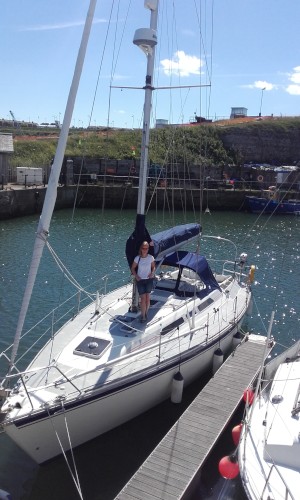
Who: Donna and Peter Cariss
Port: Hull

